All, Learn
Hanging off one of the more distant of Indonesia’s haphazardly strewn eastern islands, you can find a little baby of a nation – Timor Leste – just 12 years old when Rat & Dragon rocked up. We’d covered 30,000km across the surface of the earth to get here from the frosty winter corner of Hyde Park, London. Funnily enough, when our minivan pulled into the dusty capital, Dili, we were about the closest we’d ever been to Australia, but one look around made it instantly clear – we’d never been further away.
We started this leg of the journey in Bali. It’s practically an Australian enclave, connected to its adopted “mother country” by a dozen flights a day to all Aussie capitals, plus a cruise liner or two, and an armada of cargo vessels and private yachts. You can get a Big Mac or skinny mocha frappachino anytime of the day or night. Everyone will speak English, and most of the locals will even greet you with “G’day”.
Here though, in this scruffy little town 600km closer to Darwin, it’s very, very different. Thanks to 400 years of Portuguese colonisation (muito obrigado) the local language is Portuguese. They flew back to Portugal in the 1970’s, leaving the locals to scrap for control, first amongst themselves, and then against the Indonesians. Things got dire and the UN stepped in to break up the tussle, before setting up some semblance of government and infrastructure. And a semblance is all that they’ve managed to cling onto to this day.
It’s a pity, because it’s goddamn beautiful. The sea is clear and packed full of incredible sea life. The mountains are lush and scented by raging crops of coffee and spices. Then there are the beaches. Wow. Our favourite is known locally as Christ’s Backside Beach. It’s a long, secluded arc of white sand, lapped by turquoise and fringed by coral reef. It’s hot, and there are no drink stands, so bring your own water. And a fishing rod.
Why “Christ’s Backside Beach”, you ask? Is it because of its semblance to the Good Shepherd’s booty? Hardly (who knows what His Holy rear end looks like anyway, and how could it look like a beach??) No. It’s so named because, just as in another, slightly more famous formerly-Portuguese-ruled city; Rio de Janeiro, there’s an immense statue of The Messiah, arms outstretched, and standing at the precipice of a dramatic promontory. He’s a little smaller than Rio’s, but still quite something to see. And since he faces across the bay and towards to centre of town, his backside faces the beach in question. No offence to the beach intended, of course. Sadly though, your Rat & Dragon crew had much more important things to do than laze about on glorious (and curiously named) beaches. Instead, we got busy looking for our way across the last stretch of sea. We were seeking passage to Australia.
So we tried everything. We broke into the docks, speaking to everyone from crusty pirate fisherman and salty sea captains to dockworkers and even the harbourmaster himself, visiting twice a day. We lurked around the tiny beach just off the yacht anchorage and pounced on any tenders coming ashore. We blagged our way onto an Aussie mining company’s heavy duty helicopter port, plied the shipping agent’s offices, chatted up restaurant and resort owners and even had local legend and ex-freedom fighter (now documentary filmmaker) Maleve on the case. While this was happening, we were also negotiating our next film project (the THL Campervan film series) and they’d asked us to start asap – the following Monday, in fact. We hadn’t confirmed the deal yet, we were just waiting for their green light, but time was running out to find a boat.
And then, just as it looked impossible, we found a container ship that was due to depart Dili on Wednesday and arrive in Darwin on the Friday. Perfect timing! This was our hottest lead yet after so many had led us back to the Dili Backpackers disappointed. We turned up at the dock on that morning. Our plan was to ask a crewmember to introduce us to the captain, who could ultimately make the decision as to whether we could board or not. We were packed. We had our passports to show. We were ready to ship off in an instant. We found our crewmember, and he broke our little dreams to pieces. He said he’d love to introduce us, and that he was sure it would probably have been ok for us to travel with them, except that just yesterday, the ship’s schedule was altered. Its Darwin-bound cargo had been offloaded and it was to return to Singapore instead. We had lost our chance. Missed the boat, as it were.
We could wait until it would return, he suggested helpfully. It would be back in 3 weeks. It was bittersweet, then, when the campervan project was confirmed and the start date was to be Monday. Yay – new project! Boo – we’d need to get a flight to make it there in time. Still, 30,000km overland to that point, and just a short 50-minute hop across the water to Darwin, where we knew we’d have a campervan to take us the remaining 10,000km across Australia. And it can’t be said that we didn’t utterly exhaust all other avenues. And besides, maybe sometime down the track we can make passage by ship, just to complete all sectors overland. But for the moment, our little setback gave us a chance to really take in our surroundings.
After Bali, the Indonesian side of Timor had been quite something. A small-ish town stretching from a large port Northwards along the coastal road, Kupang has its own small yacht club that hosts events (one of which we crashed) for passing groups of leisure sailors from all over the world. A couple of high-end hotels enjoy the sea views and the night markets team with curious and friendly locals always keen to add you on facebook, share everything they own and do and stay in touch for years to come. Despite our Dragon contracting Typhoid, Timor’s incredibly helpful and sweet people and amazing local music scene stuck in our minds (and on our facebook pages).
East Timor was a different story. Whilst there are many family ties across the border, the atmosphere amongst the East Timorese was strikingly different. Where people would grin and chat to us almost instantaneously after getting on a public Kupang mini-van, Dili’s residents were WAY more reserved, to the point of eyeing us with suspicion. We made friends with some very cool people, a hairdresser in the mall, some of the dock workers, our hostel’s family and Maleve, but despite their friendliness, some bore deep scars (in Maleve’s case physically visible) from their country’s recent and bloody fight for autonomy.
The UN left in 2011, and all institutions and ex-pat creature comforts fell into disuse. Other organisations remain, helping develop the county’s agriculture diversify and shifting the economic focus on raw materials, but with 50% of the population illiterate and 34% or the people living on less than $1.25 a day, trust in the abstract concept of government is scarce. “I don’t think they’ll make it” – these were the damning words of one of the German NGO workers teaching workplace safety at the dock. What happens when a country and its residents collapse?
Understandably, trust in authority has been betrayed so many times in the past, people in general trust the people in their close surroundings way more than any other entity. The harsh reality of this tribal mindset was brought home by a doctor friend we made. Having only just arrived for a 6 month work placement, she had to amputate a 22 year old’s arm on her second day at work. A tumour in the girl’s shoulder had been treated by a local with traditional medicine for 2 years, growing and cutting off circulation until it mummified her arm completely – only then did her mother take her to hospital. Another friend collided with a motorbike writing off both bikes. The police weren’t involved. Insurance? What’s that? How much compensation changed hands was decided between the village elders and his representative – luckily he found Maleve.
But in the midst of all the rawness, the lack of infrastructure, the shadow of recent trauma there was a fighting spirit, and people sticking to their families and friends on a deeper level than most friendships ever get tested. There is an endurance and lust for life, which just needs to be channelled into the right projects to get things going, most importantly without patronising or economically taking over the country. One option for growth is certainly the tourist sector.
The island is stunningly beautiful and well worth exploring. If it’s really off the beaten track you seek, you fill find it in rural East Timor. And be aware that if there isn’t a beaten track, there won’t be a western toilet, or a place to buy Fanta, or an aircon bus, or someone to cart you out within 10 minutes if you get sick. But you’ll meet some incredibly interesting people on empty beaches, about 2386km away from the nearest Lonely Planet.
Dili, East Timor. It was a real test for the Rat & Dragon crew. It’s a challenge to get there, and a challenge to be there, but if we’d wanted life without a little adversity, we would have stayed at home. That’s why we are very proud in the knowledge that we’d made it there. We’d stared Christ in the backside and experienced East Timor, learned a lot about its history of tragedies and triumphs, and loved it. We left with great memories, new friends, and a hell of a travel story.
All, Learn
Hellooooo. Helloooooooooooo……. *pat on the cheek* Hellooooo? Ah, hello! How are you feeling today? Good? Yes, of course you’re feeling good, you’re chilling on Bali! Whether you’ve just emerged from your washed-up-and-partied-out Kuta haze or have been finding and unwinding yourself in one of Ubud’s yoga sanctuaries (or have even chased the ultimate ride or giant manta rays on Nusa Lembongan), you are going to have had the time of your life on this amazing island. We don’t blame you, we’ve thoroughly enjoyed this rather unique and crazy little spot in the middle of the deep blue sea ourselves. But sooner or later, there comes a time where you may be starting to feel that little niggling urge to explore further afield once more.
You may also have just arrived in Bali, seen the massed and thought “well, f*ck that”. There are, of course, plenty of untouched and wonderful places to enjoy on the island of the Gods (hang on, wasn’t that a place in Greece too?), but if you’re ready to cross a little piece of ocean to Indonesia’a many other islands, there is a very cool overland alternative to sticking yourself in a tin can with wings and 50 other jabbering people: get the ferry (with 5000 other jabbering people you might otherwise never get the chance to meet)!
You can read up on our overland travel from Singapore to Bali in “Bagus or Bonkers? PART 1“, where you’ll find a beginner’s guide to Pelni, Indonesia’s premium public ferry operator. Check out all sorts of very useful overland travel info elsewhere on Seat 61. Alternatively, dive straight into the Rat & Dragon step-by-step guide to travelling overland in central Indonesia. All prices at time of writing, i.e. June/July 2014. DISCLAIMER: We would love you to have the best holiday in the world, so please always check these details locally as embarkation locations may change randomly (this is Indonesia, remember!). Otherwise, enjoy!
Bali to Timor: Ferry
1) Pelni Ferry from Bali (Benoa) to Kupang, via Bima, Waingapu, Ende, Sabu and Rote, 73 hours, 1st class: IDR 1’304’000 pp
That’s quite a mouthful of a ferry journey already, we know. But in addition to the short distance inter-island day ferries, the Pelni service offers a great way of covering longer distances and takes you from city to city, as opposed to travelling from muddy beach with one boat ramp to river-mouth mini harbour 8 hours drive from the nearest town. This route is relatively infrequent at once every 3 weeks, but if you have the time or just want to stop off in one or two places, then this is a great way of seeing authentic Indonesia because, well, you’ll be doing exactly what the other thousands of Indonesians on your boat will be doing with you. Being all Indonesian ‘n stuff.
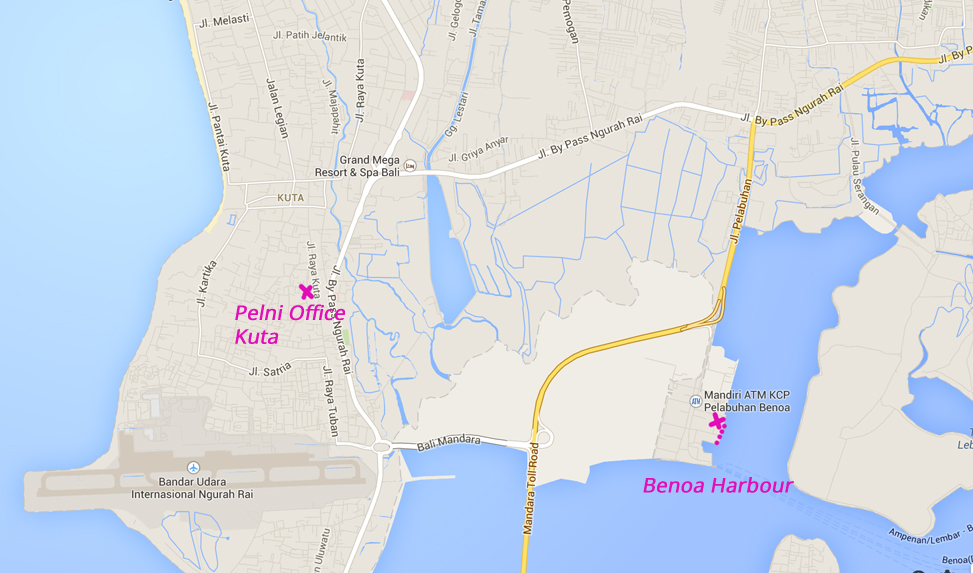
Getting information and tickets was quite a bit of a handful as everyone seemed to know where the Bali Pelni ferry office was, but no one could actually get us there. There are a few strewn across the island: Benoa harbour’s branch was always closed, the travel agent on the way to the pier had no idea what was going on, and everyone we asked were keen to convince us that their version of geography that happened to contradict all others including a map was in fact the one to take note of. “Oh, yes, it’s right across the road from Supernova shopping centre (a TINY crumbling mall with next to no outside signs, why would you need those?), you can’t miss it” actually means ‘nowhere near Supernova shopping centre but 15 mins walk in the opposite direction to where your new friend is pointing’.
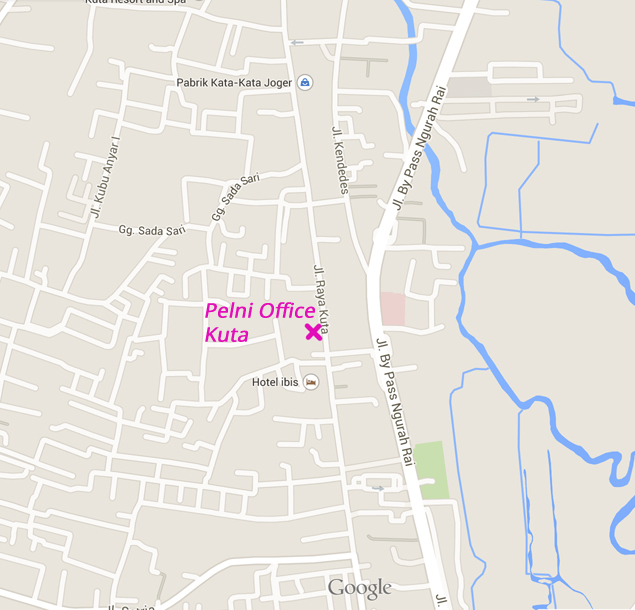
After researching for ages we found the following address for the Pelni Bali head office: JL. Raya Kuta, No 299, Tuban, Denpasar (+62 361 765758) but there are as usual several Raya Kuta roads, no visible house numbers, google maps shows this place as being another abandoned shopping mall and no one picked up the phone. Several trips and detective work on our little scooter landed us at this place further up the road – finally we had found it! Please enjoy a map and photo of the building for your viewing pleasure.
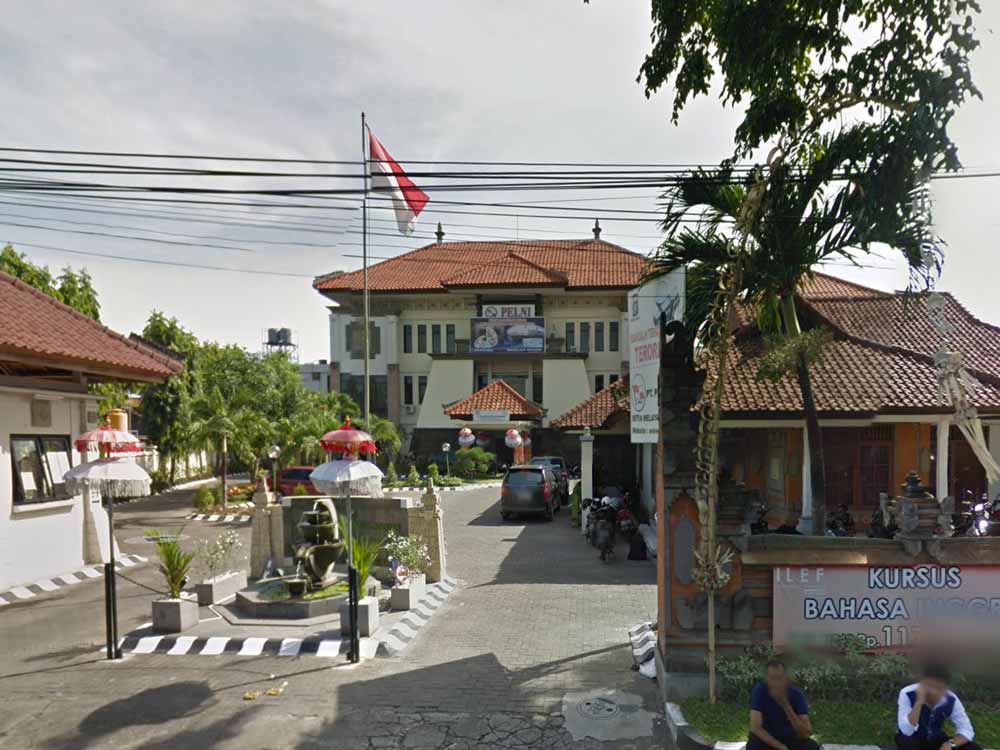
Buying tickets in advance this time (due to, you know, the whole Ramadan thing), we had the choice of economy (mattress spaces on the floor in a huge room, see this blog for pics of the equivalent class on the Batam – Jakarta service) at IDR 428’000 per person, 2nd class (gender segregated 8 bed dorm rooms, see our pics in Part 1) at IDR 1’221’500 per person or our private 1st class room for IDR 1’304’000 per person. Due to our kit needing to be secure, it was all a bit of a no-brainer. An hour later, minus a wad of cash (no cards again!), we left Pelni head office with a pocket full of rainbows, namely our first ever first class tickets to anywhere.
Chill in Bali for the required amount of time to get all excited about getting on a ferry into the darkness. Check out some surfers; don’t get mugged by the monkeys at Uluwatu temple (unless you’re into that kind of thing).
On the designated departure date, take a Blue Bird taxi to Benoa Harbour, check whether the boat is there yet and if not, grab a bakso from one of the shops by the carpark. Our boat, just as our previous one from Batam ended up arriving more or less on schedule at our final destination, but was 5 hours late leaving. We had heard rumours that being as early as possible is imperative as even if you have a ticket, you’re not guaranteed a place. No pressure then – chill with everyone else and sitting on the pier.
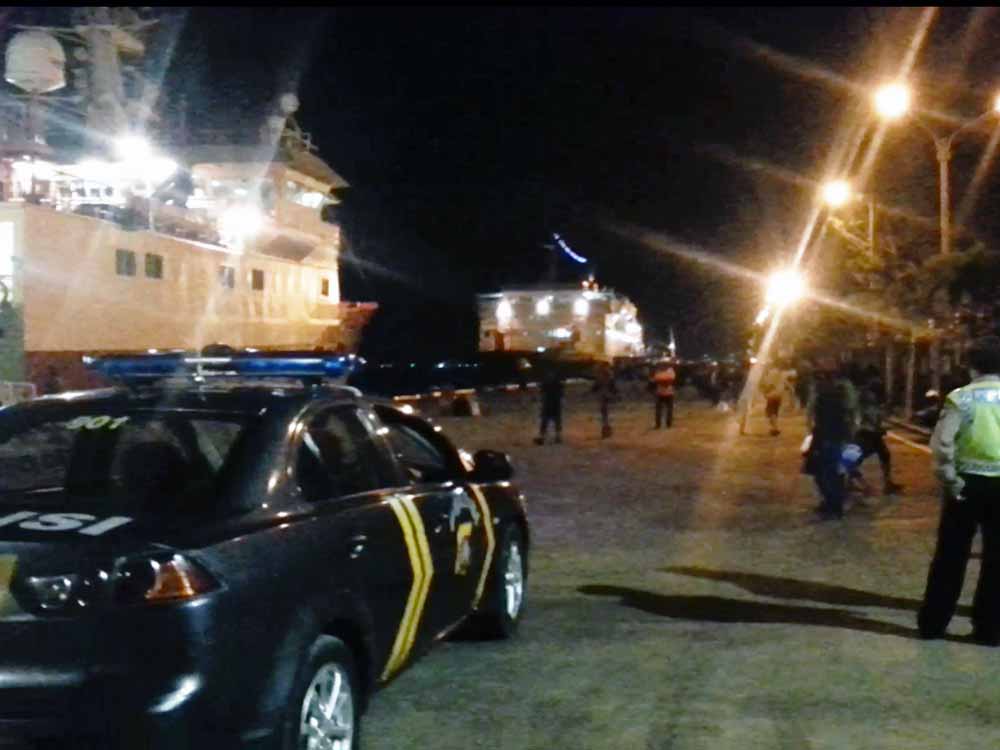
OUR BOAT TO TIMOR! (at the end of the pier)
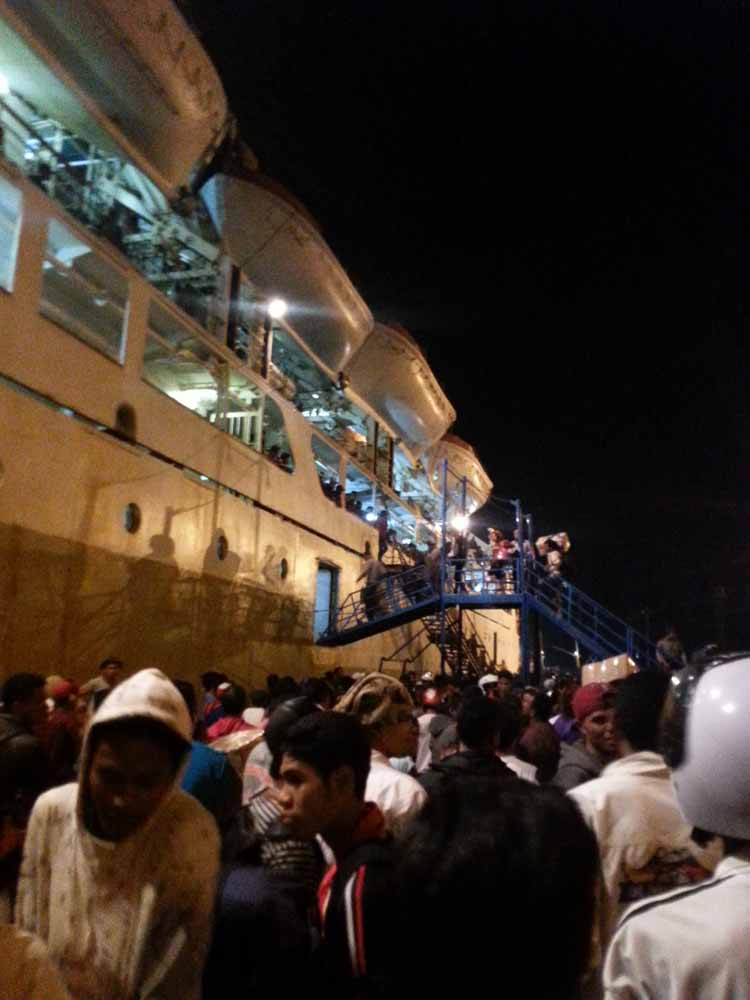
If you thought getting on the boat in Jakarta was fun, you’re in for a treat. As thousands push their way onto one tiny one-person-wide gangplank with no sense of queuing, be prepared to have boxes, kids bicycles and bags of chickens rubbed in your face from all directions. There are a few guards peeling off people climbing the outside of the gangplank to queue jump, but we were separated just before getting onto it which meant Nicola was waiting just inside the heavy metal doors of the boat for 45 mins before Saxon managed to make it.
Make friends with the angry guy in uniform blowing his whistle aggressively and shouting at everyone. For good reason – getting on the ferry seems to be a nostalgic extension of the mosh pit that was queueing for the kiosk in primary school. The moment everyone finally gets into the ferry, they don’t move to their berths but block the entrance whilst shouting at their particular friends to catch up. Lots of laughter again, we learned later this was all part of ‘national tradition’.
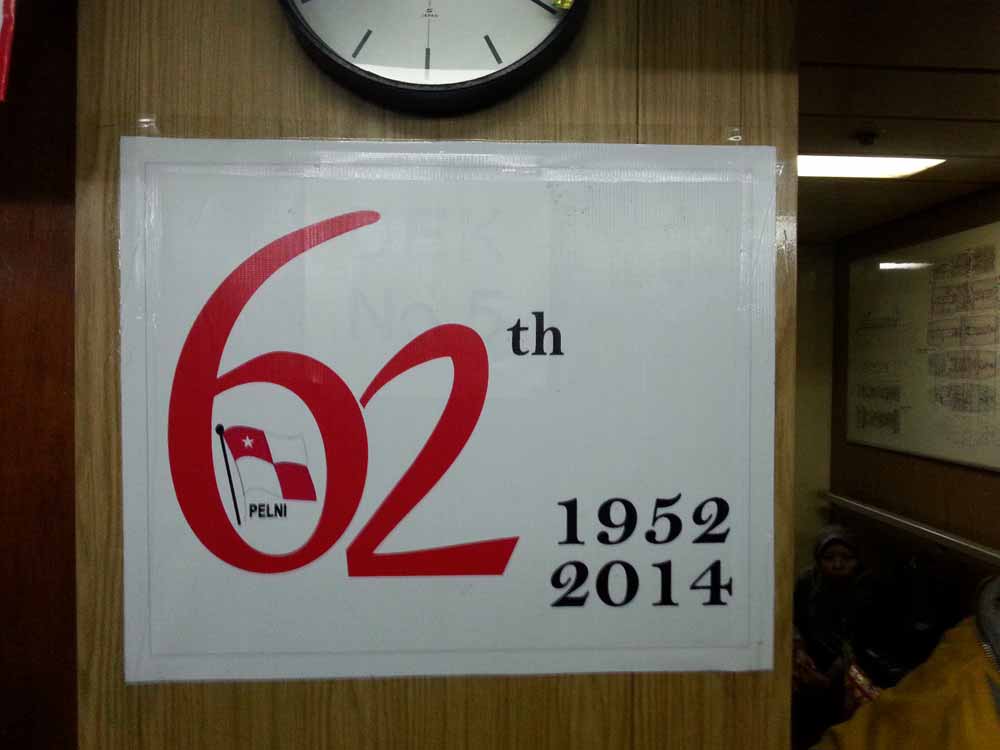
Maybe the ‘no space for late comers’ rumour had been going around. Maybe everyone was keen to celebrate Pelni’s 62th anniversary. Either way, join the party.

Our cabin was fantastic, we even had blankets, electrical sockets (bring a multi-plug!) a little desk and a TV that showed an exciting feed of the empty the dining area. It was rather hot but the group of rowdy teenagers camped on deck outside our window playing Angry Birds Star Wars Edition on their Samsung tablet was a little windswept and cold, so choose a location to suit your personal climate preferences. Outside may also have been a little bit too loud to hear the rooster crowing on one of the lower indoor decks. The metal hull reverberated perfectly every morning in a glorious unison of machine and beast. Who would have thought.
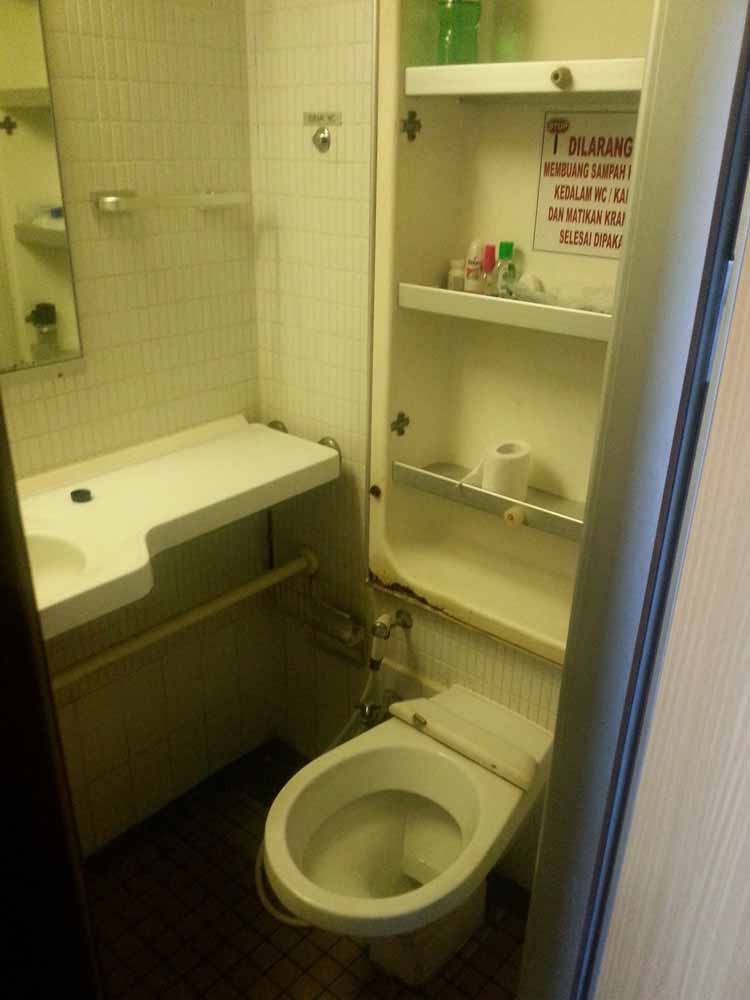
This particular ferry did suffer from a recent invasion of toilet-seat stealing elves. To compensate, there was small cold water shower and sink – all very shabby but a real upgrade for us so we were over the moon.

Cone-hair lady disapproves of you standing on the bed.
If you are travelling 1st or 2nd class, enjoy free of charge breakfast, lunch and dinner in the dining and entertainment area at the rather odd times of 7am, 10:30am and 4:30pm. Fish, chicken, rice, unidentifiable vege and some fruit for dinner desert. Alternatively (or additionally) ask the kitchen for a flask of boiling water and cook your own pot noodle but note the dining area is used for other events such as Christian sermons and group talks at non-feeding times. Muslim prayer times are announced throughout the day via the ferry’s loudspeaker system as a room large enough to hold all devotee passengers would be the size of the boat. So they use the boat instead.
Note also that the price of food and drinks brought from the shop may vary depending on the level of your tan and Indonesian language proficiency. Smiling and politeness always help, even if it means an enthusiastic fellow passenger offers to take your coins and buy things for you. Friendly banter is a big part of the trip, so don’t be shy, dive in and get involved – you won’t regret the enthusiastic mass movement you’ll become part of within minutes. Loading and unloading times are always especially exciting.
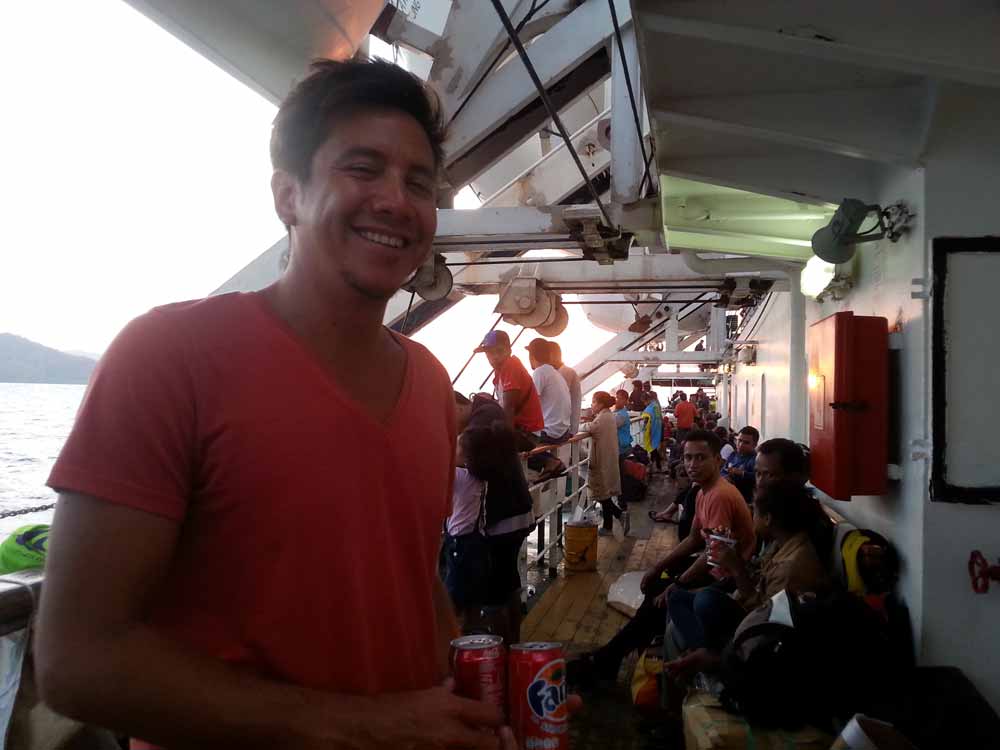
Jump off in Bima to access the Komodo Islands or sail past them down to Waingapu. Yes, this is a real name of a real place. So is Cockfosters on the Picadilly Line. Enjoy the view of the sunrise with everyone else, especially those with pole position having set up camp inside the lifeboats. Be proudly told by said pole positioners that it is far less breezy than on deck, so they push one person up the gangplank early to reserve lifeboat 17F (visible in the top left above Saxon’s head) every year.
Jump off in Waingapu to explore the Island of Sumba at your leisure. We have it on good authority that the local horses are pretty special.
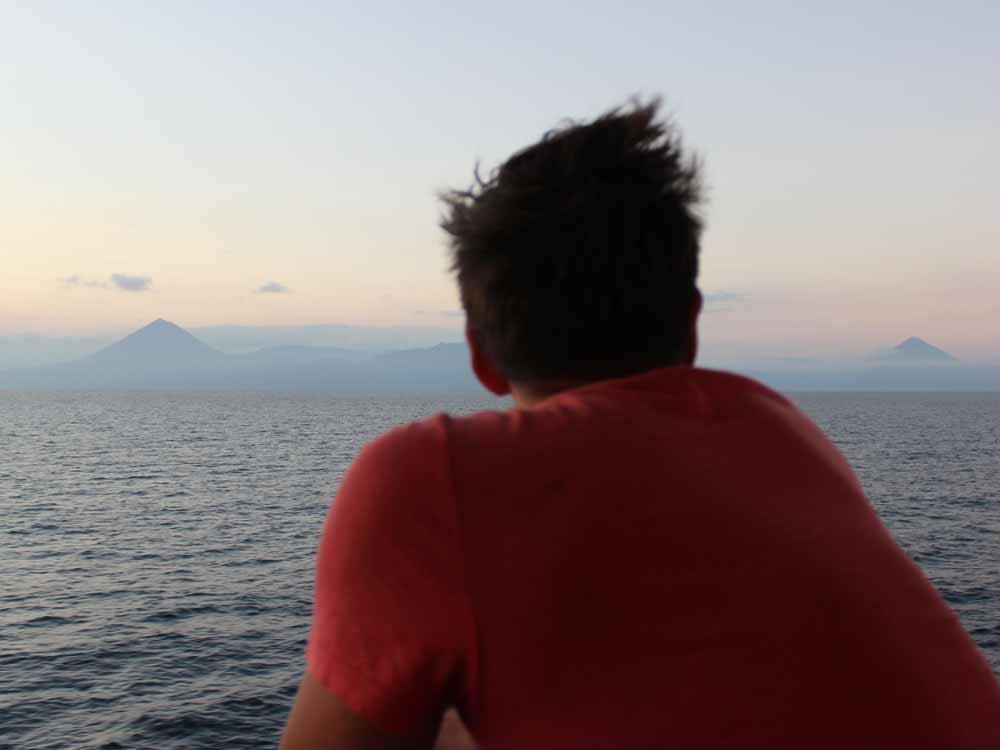
Wear the same T-Shirt as on every other photo during this month and enjoy the view of Flores Island on the way to Ende. Double volcano action, dudes.

Disembark in Ende for the Flores volcano experience. Marvel at the harbour authorities’ incredible talent to make everyone wait and let people get OFF the boat before they try getting ON. Three cheers to the crowd for remembering to wear their motorcycle helmets whilst boarding. Safety first. Especially when climbing up the side of the gangplank with a security guard clinging to one of your legs whilst your friends and other guards point and laugh. Tradition, remember?
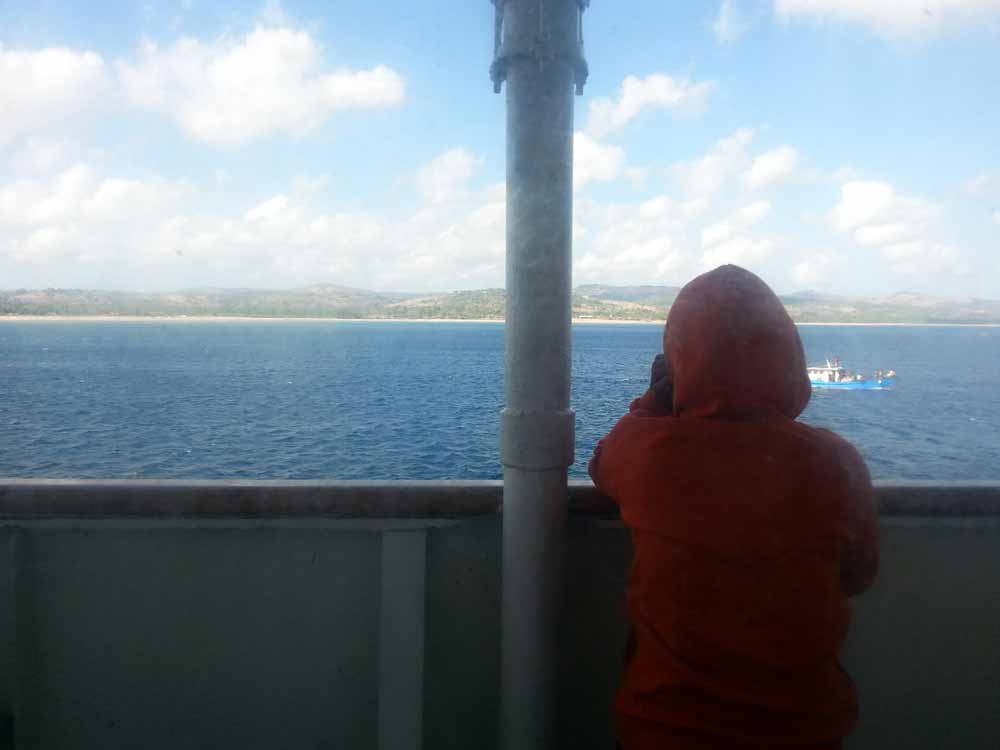
Join one of the now melancholy teenagers camped outside your window and enjoy the view of flat, non-volcanic Sabu together. Exchange Instagram details. Take pictures with everyone in various combinations. Don’t forget lunch at 10:30am.
Go nuts on Sabu for the desired amount of time. Possibly for at least 3 weeks as there don’t seem to be many other boats coming and going. Some good surf and an airplane connection to Kupang as well as being very much off the beaten track (you did ask for it!). Or keep going till Rote and surf the well known breaks as it has many more frequent connections via boat and plane to Timor Island.
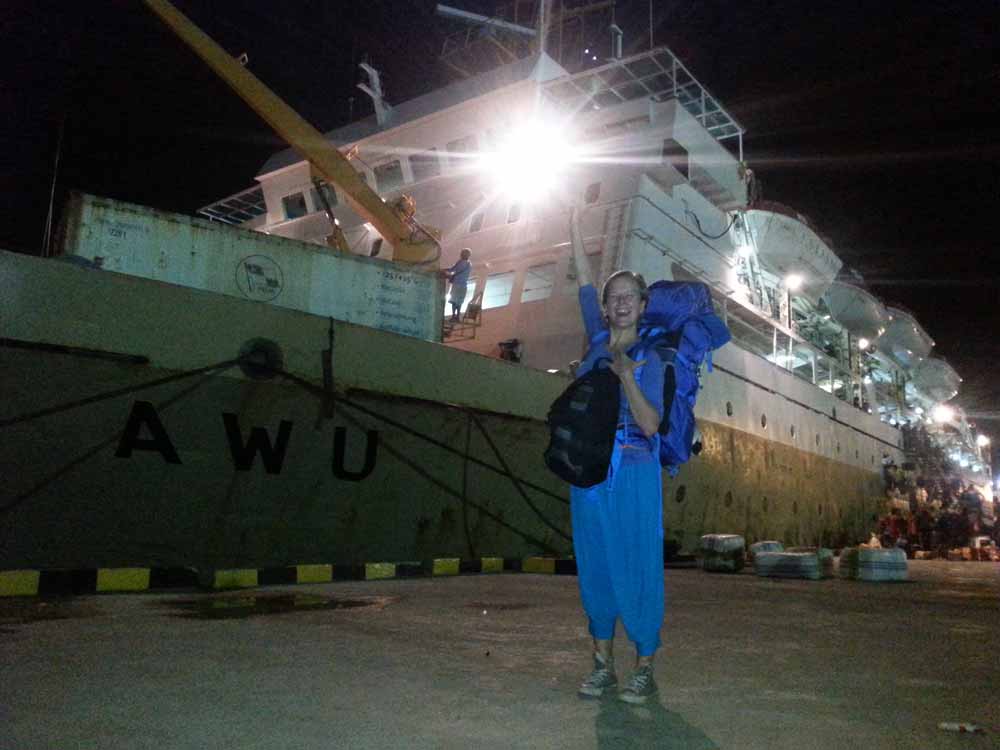
If you’ve come all the way with us keenos to Kupang – 73 hours later you can give yourself a huge slap on the back as you have made it! Welcome to Timor, welcome to Kupang, congratulations, you’ve survived three days straight on the ferry. Double congratulations if you chose economy class and an extra gold star if you got to sleep in the lifeboat.
Timor to Timor Leste: Minivan
1) Apply and receive Timor Leste Visa Application Authorisation, allow 3 days, free
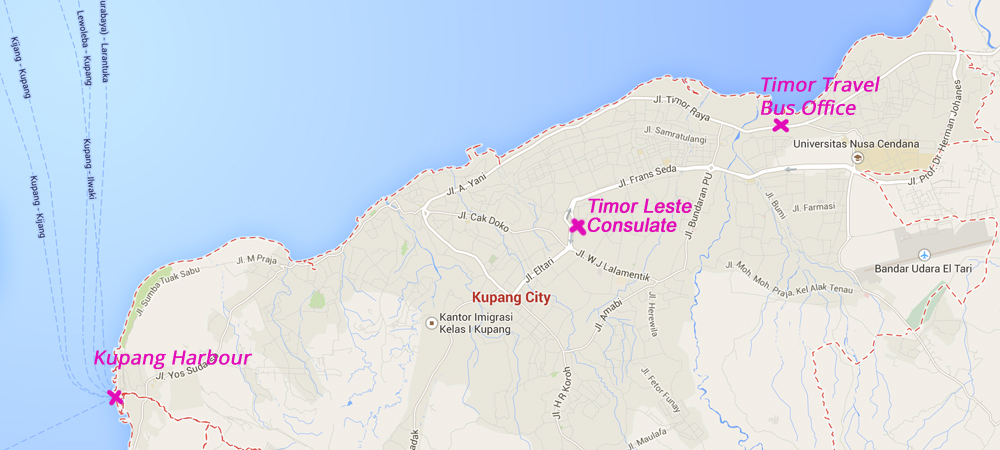
In order to travel to East Timor, you must first acquire a ‘Visa Application Authorisation’ letter from your nearest Timor Leste Consulate. YOU CANNOT JUST ROCK UP AT THE BORDER. Find full information on the official Timor Leste Immigration Authorities website, but in a nutshell, download the application form, fill it in, get copies of all supporting documents (passport copy, bank statement, return or onwards ticket etc) and take a bemo to the Consulate of Timor Leste, Jl. Eltari II, Phone: + 62 8133 9367 558 / 8133 9137 755 (neither of these numbers worked though). Here is a handy map as taking pictures of the yellow building was prohibited by one of the more Rimmer-like guards.
For those now scratching their heads with a ‘WTF Mate?’ look upon their face, a ‘bemo’ is a shared minivan-taxi-public-bus-hybrid popular in Timor. Those lucky enough to have visited Bali 10 years ago will have seen them shipping rowdy tourists from bar to bar, but they seem to have disappeared this time around. Possibly due to something accident related. Taxis are often private (Blue Bird has unfortunately not made the leap to Timor yet) and charge a minimum flat fee of 50’000, even for 2 minutes down the road, so cuddling up to smiling local youths, business men and a nun or two for 2’000 pp is a lot more fun. Plus Kupang’s bemos are fully pimped out with Avril Lavigne stickers, Jesus slogans and more cuddly toys you could ever imagine. Not to mention the impressive sound systems pumping out Vengaboys giving all passengers free tinnitus.
Wanna see what ‘Pimp my Ride’ Indo-style looks like? Check out our Bemo Boys Place Cake:

Submit your application to the friendly man at the window, and if you’re friendly back the office may be inclined to speed up your application process (expect nothing, ask politely but be prepared to wait). Once approved, you’ll be able to pick up a document like this from the same window a few days later:
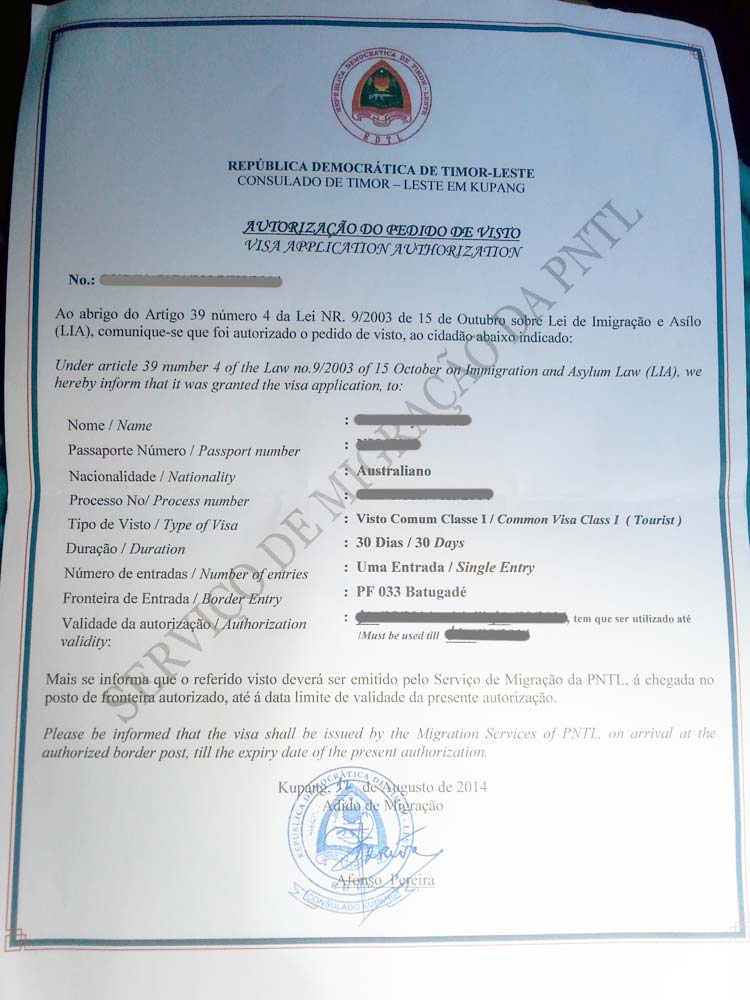
HURRAY! Don your ‘I’m all official now’ t-shirt. Only now can you go to the boarder and get a visa. To do so, book your minibus and stop…. *beat* Hammertime.
2) Minibus from Kupang to Dili, 14 hours, IDR 200’000 pp
There are several public transport options you can piece together a route from, but they will most likely require an overnight stop off in Atambua. If you have the time, great! The landscape is stunning, especially starting from Soe. If you don’t have the time, take the designated minibus service all the way.
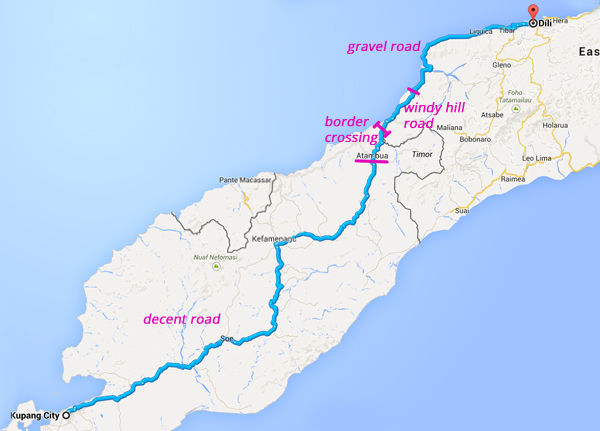
Challenge of the day: Find the Timor Travel Minibus office. You know the drill – no discerable house numbers, no one picks up the phone, about 5 different road names to chose from when naming hundreds of roads around the city… here’s the address for completeness’ sake: JL Timor Raya No. 8, Tel: 0380-881543, 882125, 8080345, 8080850. You may have more luck than we did. If not, despair not. Here are more pretty pictures.
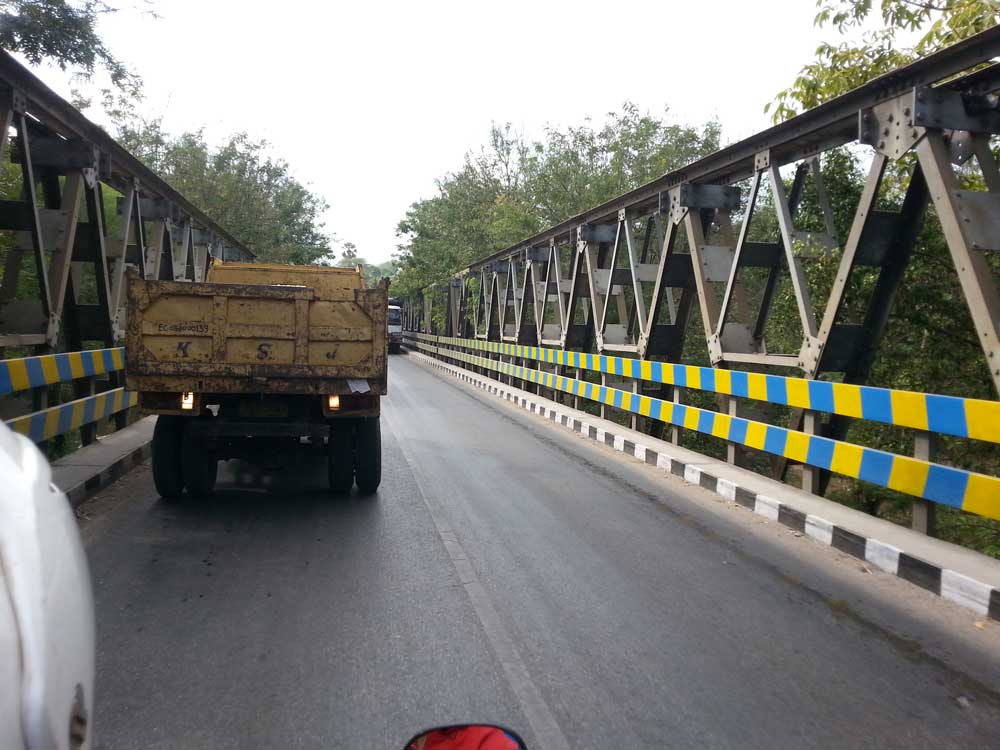
Take a bemo along Jalan Timor Raya away from the old centre of town until you cross this bridge. Then keep your eyes peeled for what most certainly is…
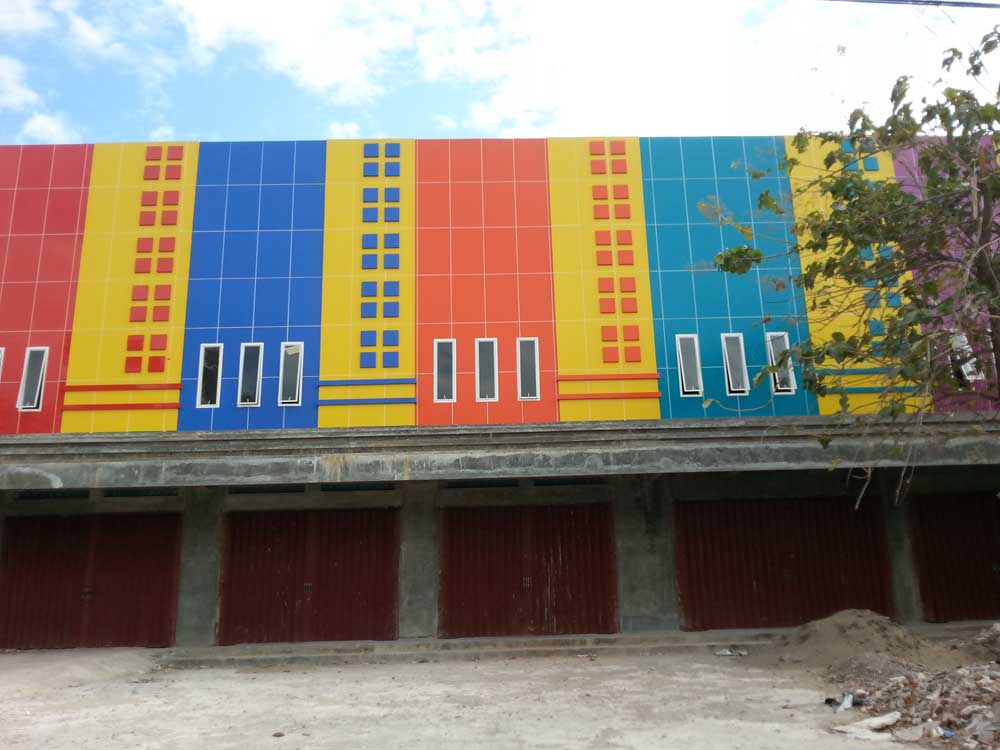
… the most unnecessarily coloured building of questionable purpose this side of the river.
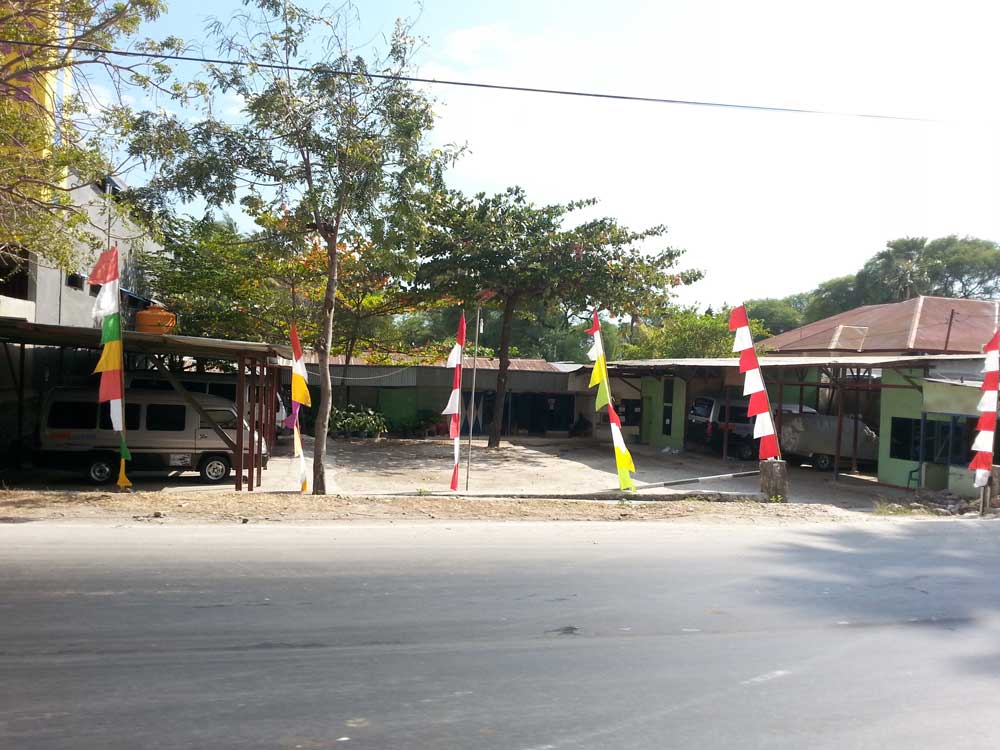
Right next to it you will find this un-assuming little car park.
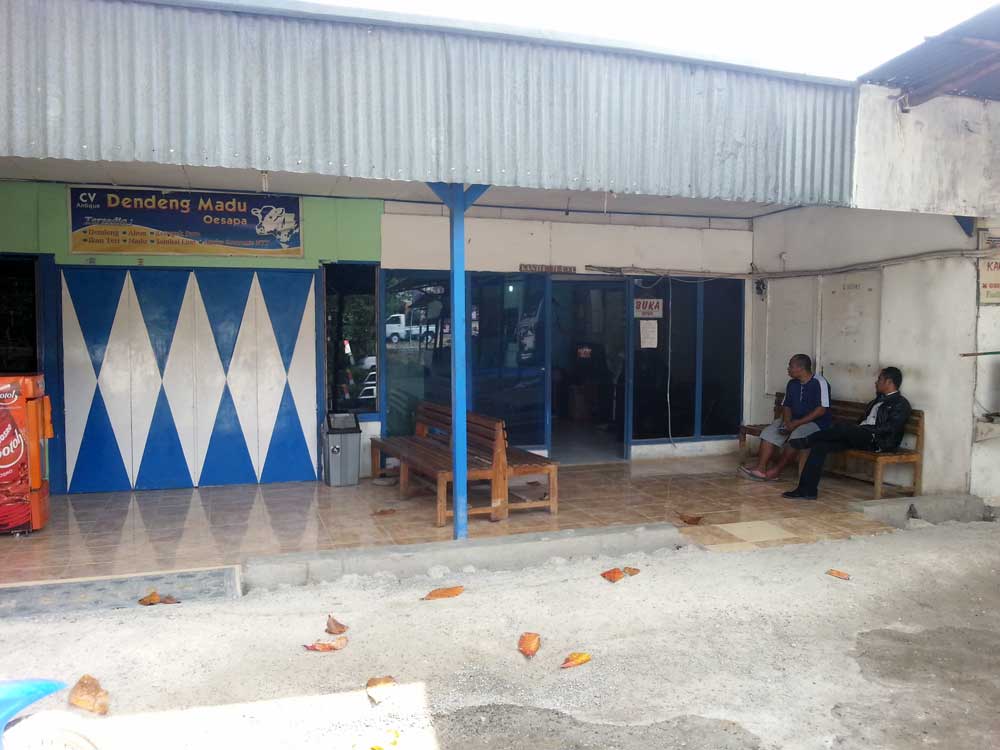
In the back on the right there is an office. Go in. Say hello. Don’t be shy, this ain’t Corleone’s.
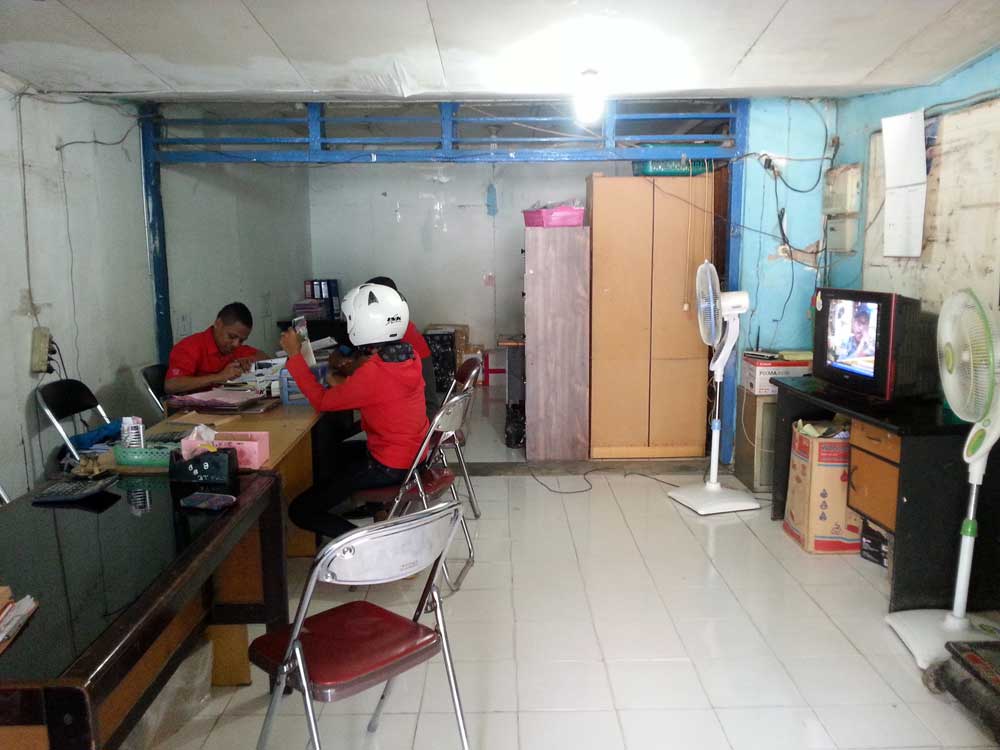
Purchase Timor Travel Minivan tickets on your preferred date (at least 24 hours in advance as busses leave at 6am before the office opens for the day). Motorcycle helmet is optional.

On the day of your travel, you will be picked up by a nice gentleman from your hotel about 2 hours before you actually have to go. Bring copious reading material. Once everyone has been rounded up, you will be transferred to this minivan. Receive a muffin and water in a cute little pink cardboard box with flowers on it for breakfast (subject to availability). Your journey has officially begun.
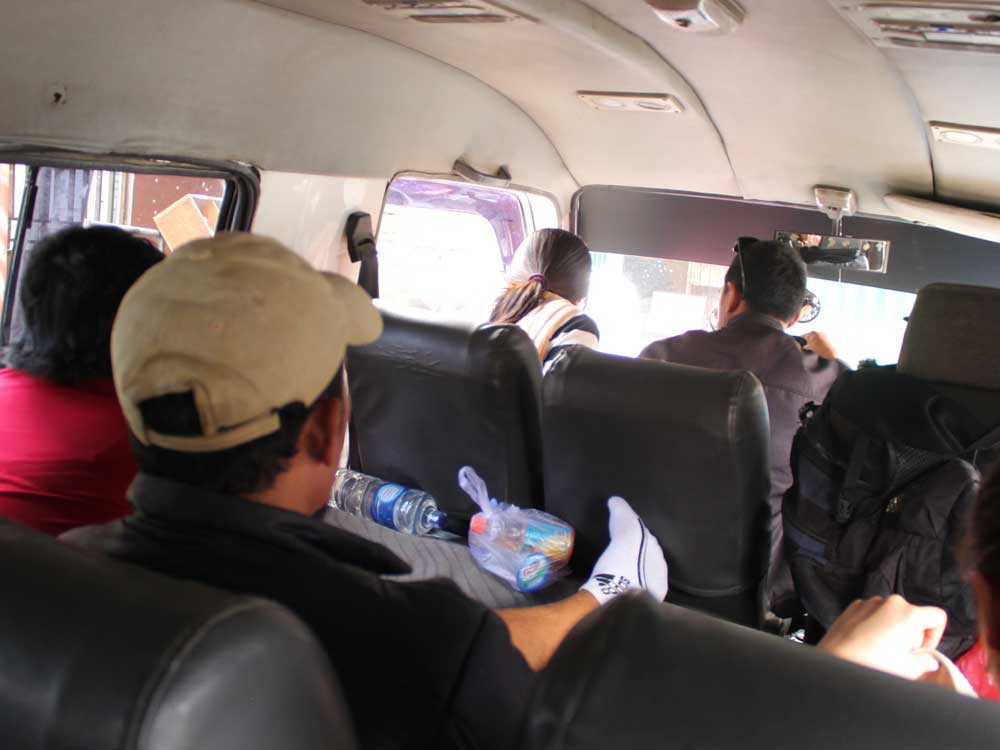
Make yourself comfortable in the minibus but note they often sell out so stick to one seat as people are picked up along the way. Only take front seat if you are in a particularly chatty mood or a big fan of the local radio station that exclusively plays twinkly love songs.
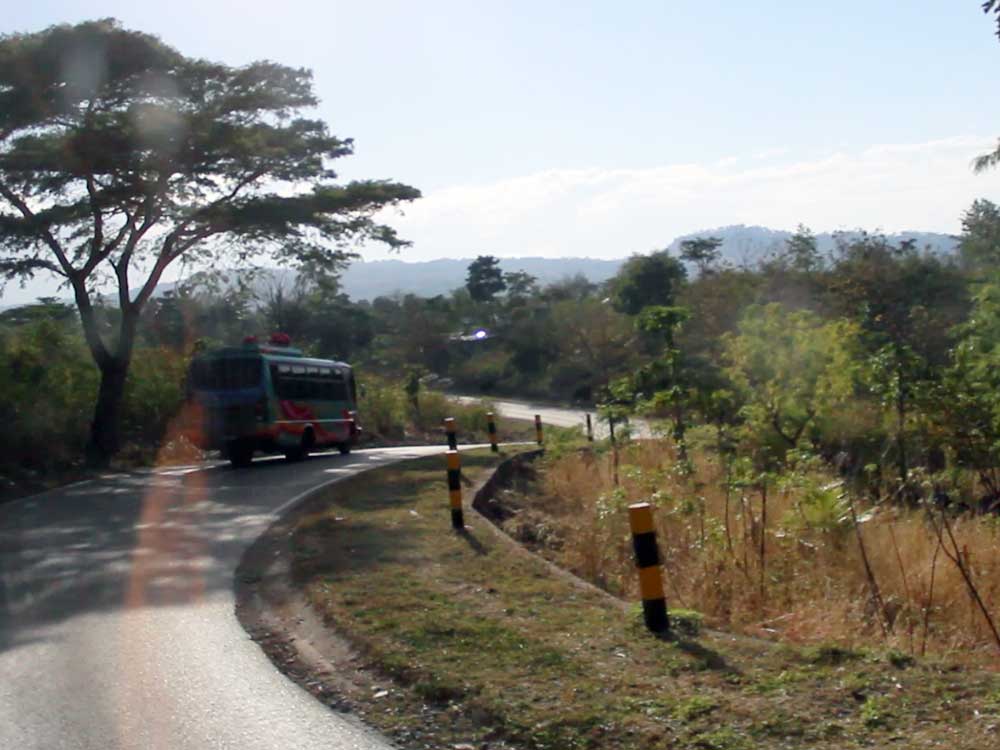
Enjoy the decent roads on the way to Atambua via Soe. Some may make you feel a little like you’re on a roller-coaster but in comparison to what’s ahead they are magic. Beware of google earth’s road layout. It may seem like the roads in East Timor are bigger than West. They are not. Check out the landscape, it’s pretty spectacular.
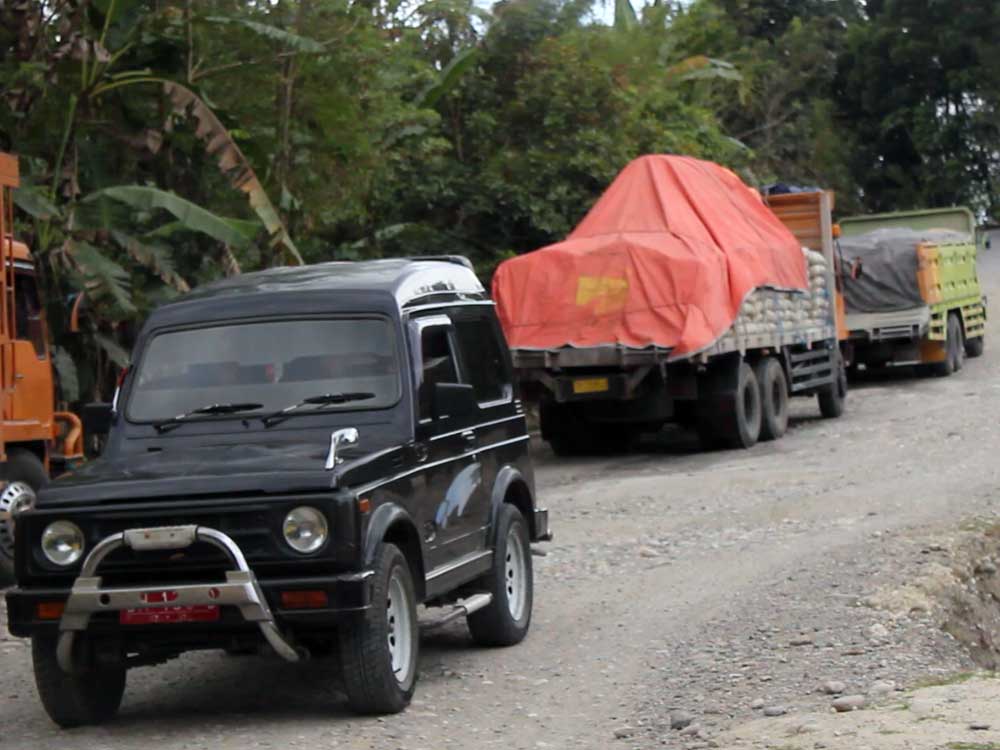
Get a glimpse of what lies ahead in some of the minor road works on the way to Atambua.
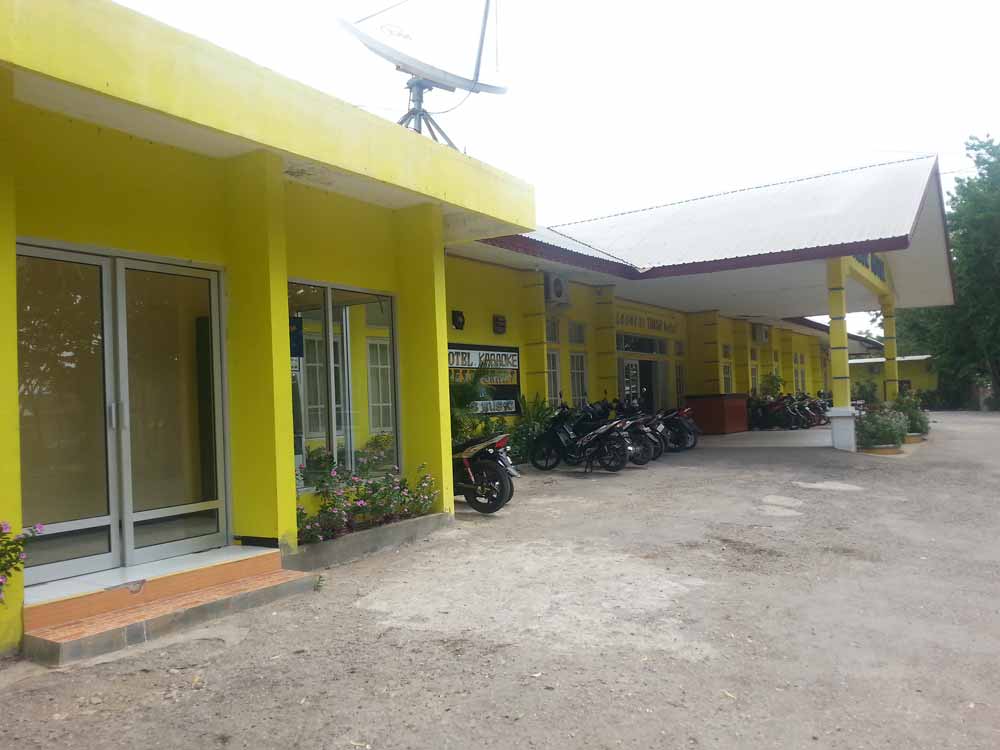
Stop off at this hotel for 20 mins for no apparent reason.

Soon after, arrive at the border.
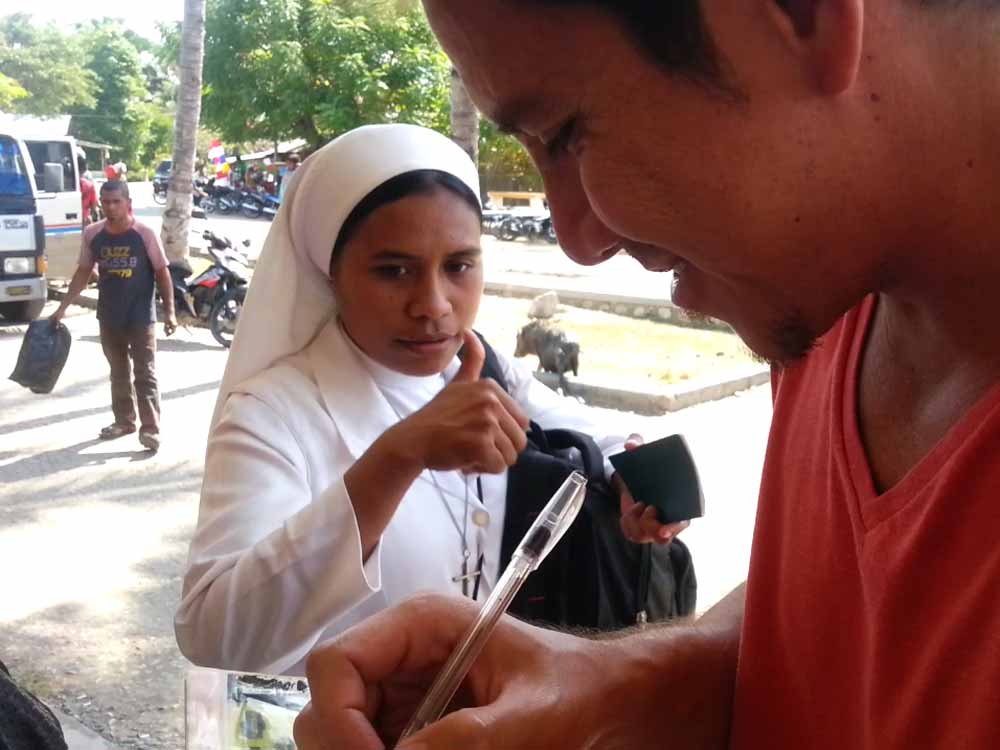
Borrow pen off rock-n-roll nun to fill in your departure card. Don’t mind border crossing feral pig in the background. No one is the boss of him.
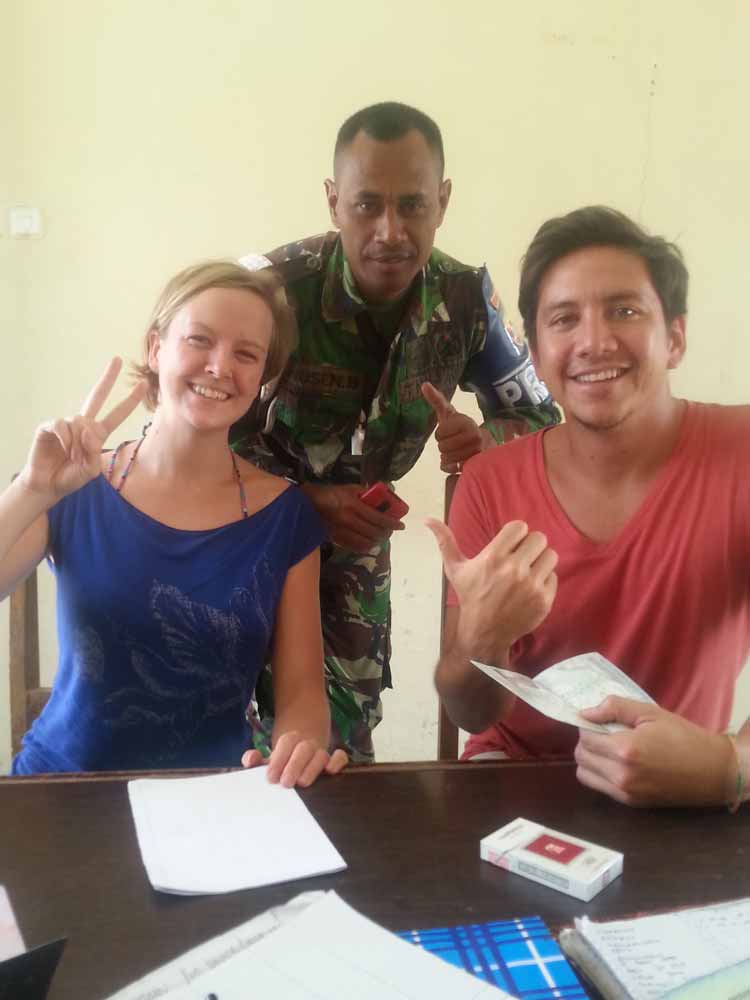
Hand in your Visa Application Authorisation. Have your photo taken with various Indonesian emigration officers. Last chance for authorities selfie time.

Cross the border, old school style. Don’t mind the feral pig following you. He owns this sh*t.
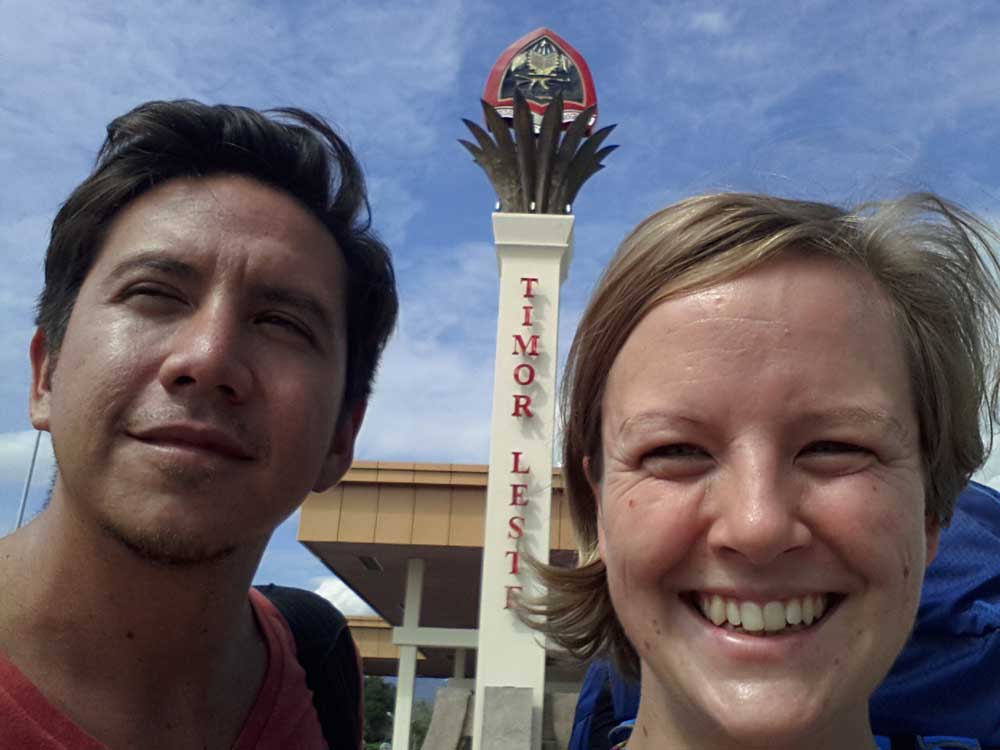
On the Timor Leste side, go to the little counter before you get to immigration and pre-pay for your visa – 30 US Dollars, make sure you have at least $50 in case officials change their mind on the day, or someone is in need of some extra cash. Karma and all that. Proceed through immigration, have your bag scanned and searched for pigs. If all runs smoothly you will have successfully made it to East Timor. Congratulations, you can now count yourself to the tiny and very special percentage of backpackers who have made it here.
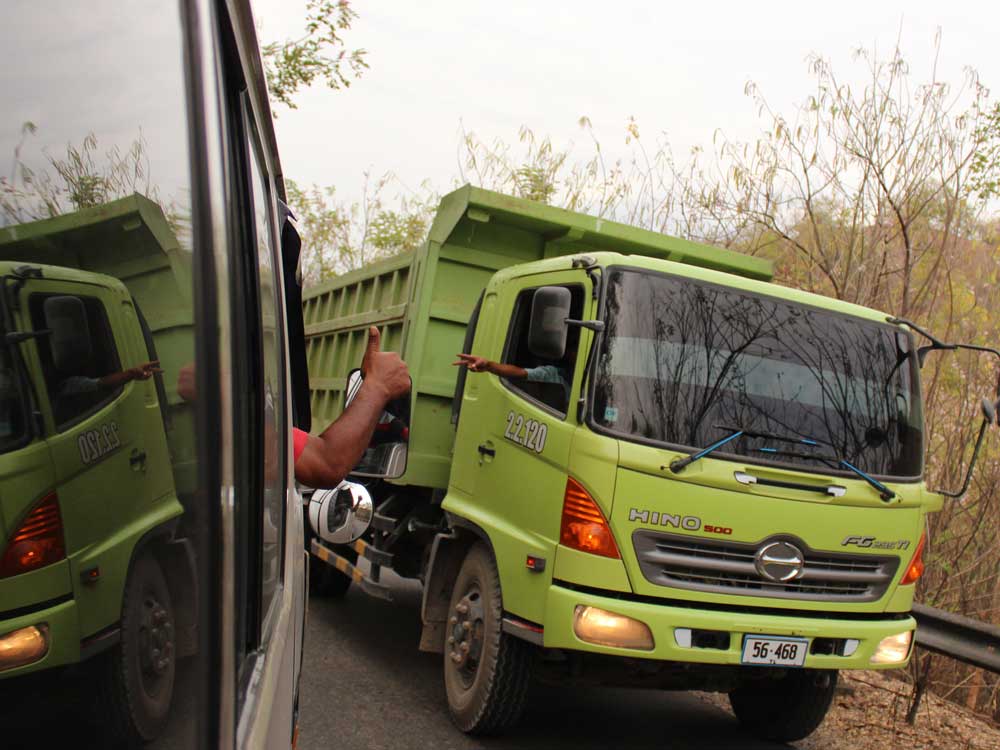
This wonderful country welcomes you first with a windy road through the hills down to the coast. Gawp at the incredible skill of lorry driver after lorry driver squeezing past your minivan and avoiding a cliff face. We counted a total of 8 in one row (currently signalling there are two left to go).
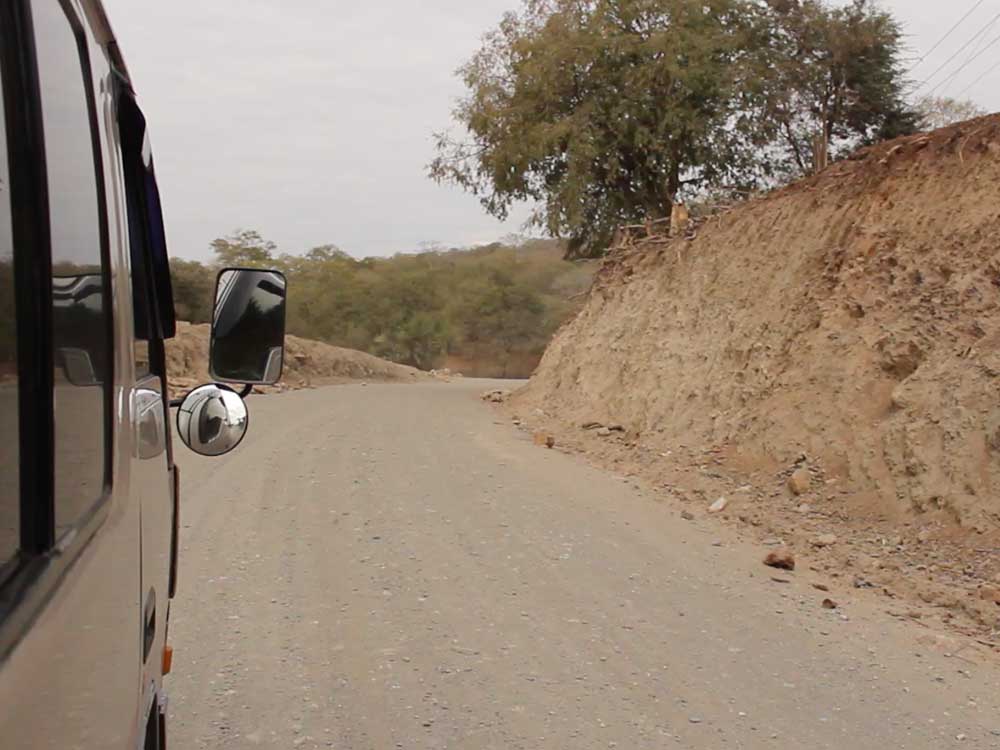
The road has been under construction for nearly a decade. No builders in sight.
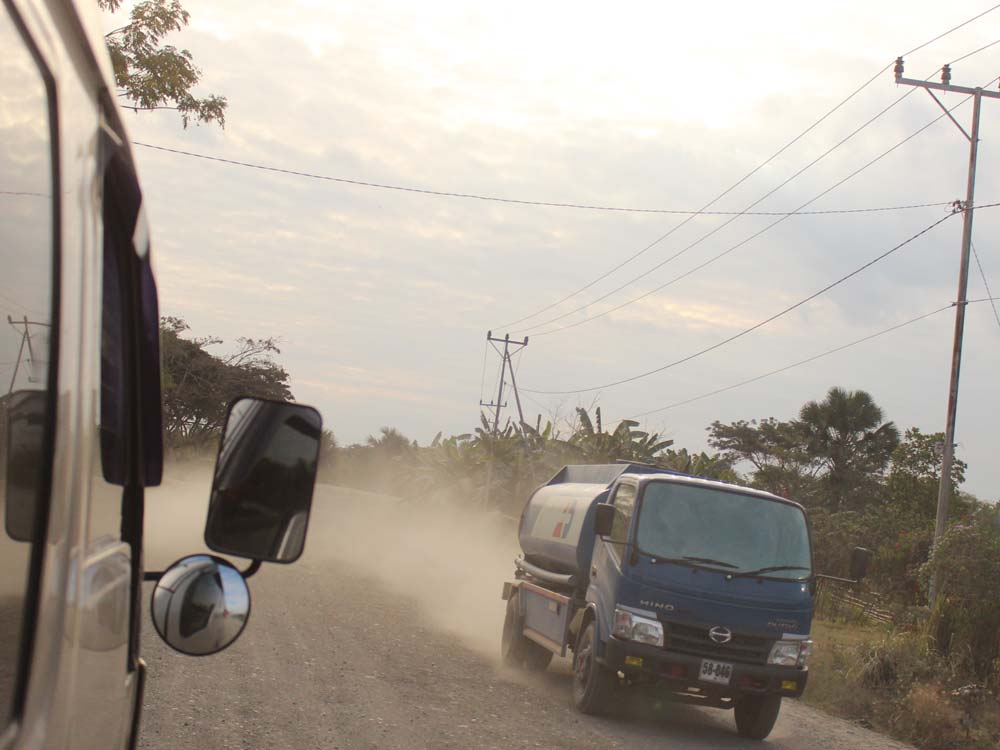
Which means lots of dust.
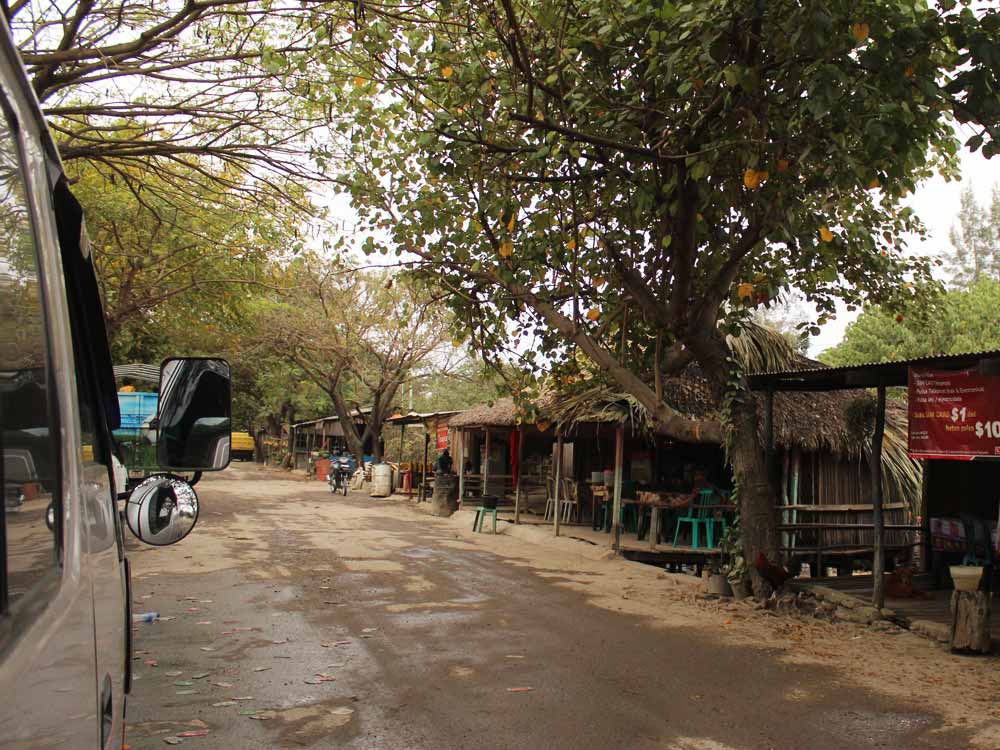
A quick stop off for snack lunch, aka a smoke for the driver.
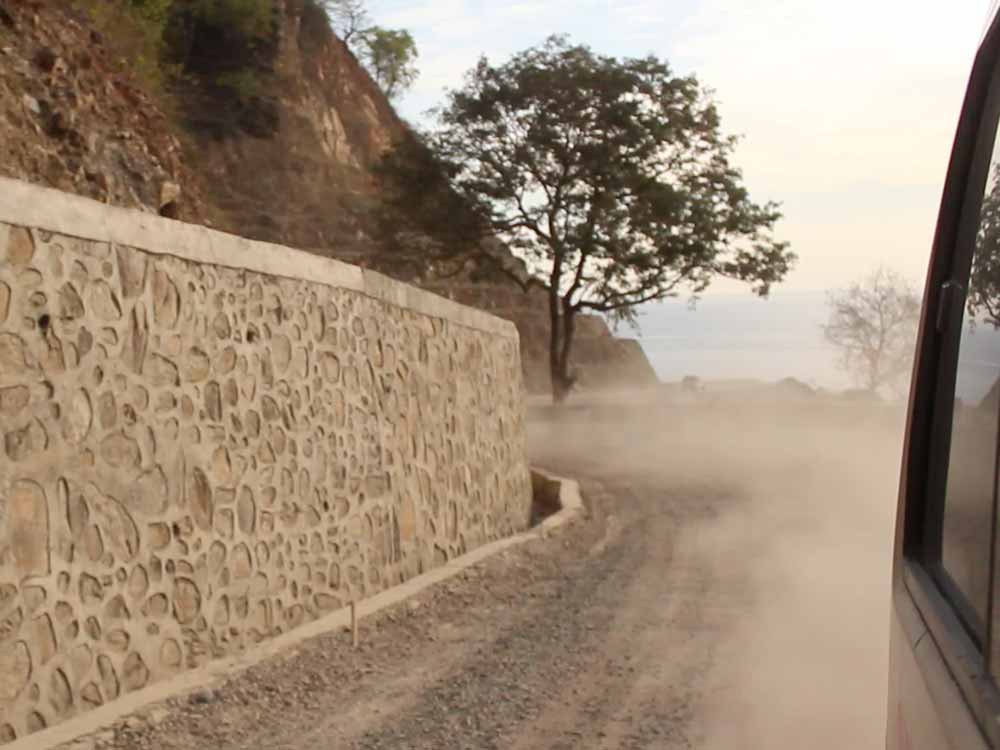
Then for some more dust.
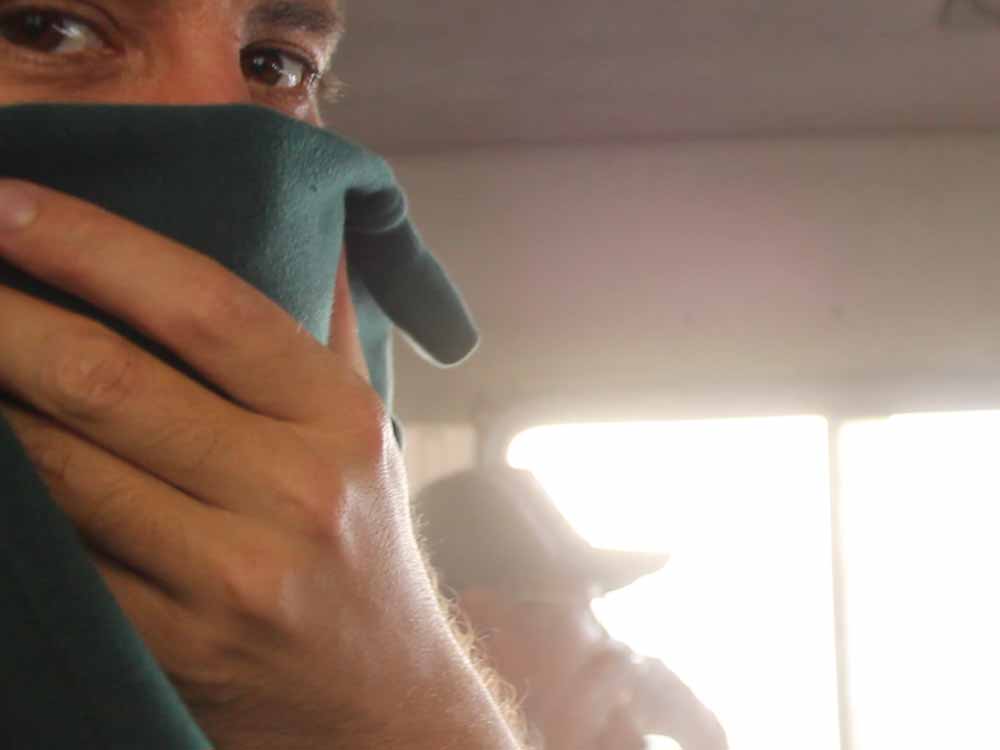
Outside the van and inside the van.
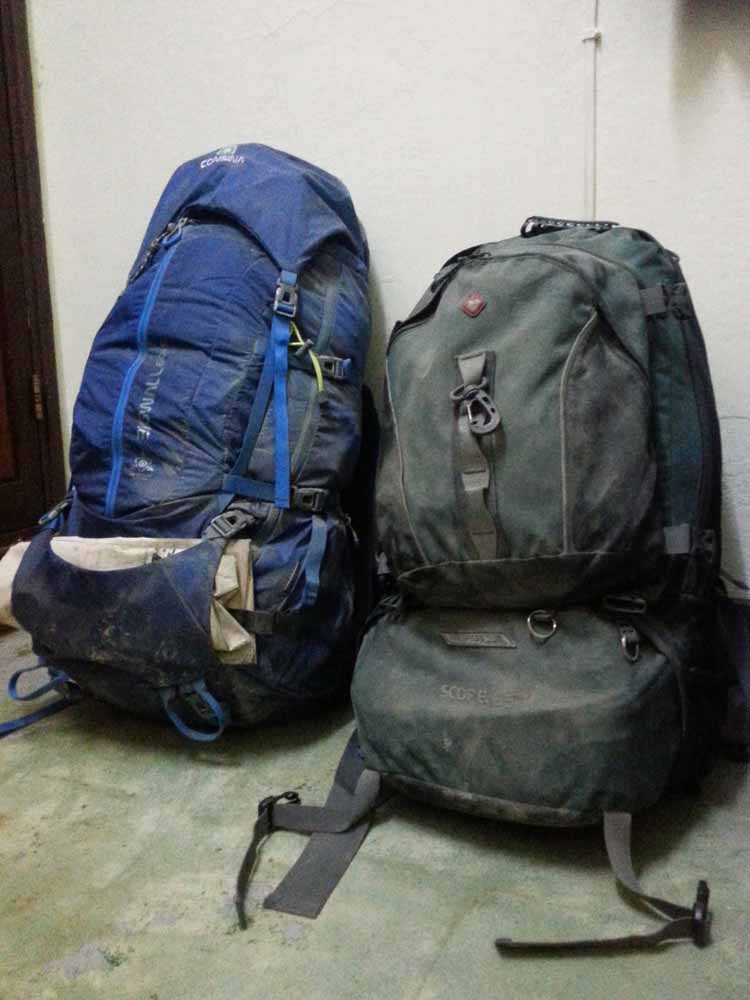
Make sure your bags are all well zipped up. The one on the right is usually very dark green and black. The left one has been cleaned and is waiting for round two.

And so, dear reader, if you can see the statue of Nicolau Lobato, you have made it to Dili. In case you were wondering (as we often did upon arrival) what the local currency is and how much it’s worth, have a bit of a surprise. Timor Leste deals in US dollars, with their own little centavo coins mixed in. There are some awesome places to explore, including ‘Jesus Backside Beach’, ‘Jim’s Crack’ and ‘Ramelau’s Bottom’, go crazy.
We hope you have found our account useful, feel free to get in touch if you have any further questions. And do let us know in the comments how things went!
All, Learn
We cannot recommend overland travel enough. Read through our last 6 months of blog posts and you’ll see why. Overland travel on public transport is probably the closest you can get to experiencing a country in its authentic entirety, the good bits and the bad bits all thrown in together as you shoot by bullet train or meander by river ferry through this wonderful planet’s outstretched landscapes giving you a real feeling of geography and distance.
Sites such as www.seat61.com have been incredibly helpful. Mark – thank you, we don’t know you but you’ve saved us many a headache. But it seems that eastern Indonesia is still rather adventurous territory due to the lack of trains because, well, it’s all a bit of a hotch potch of islands with ocean in between. After finding our way along this green line marked on the out-of-date-but-only-available national Pelni ferry map, we would like to share our findings with you, dear adventurous reader just chomping on the bit to get off on your next trip – we can guarantee one thing, it’s going to be an experience to tell your grand kids about.
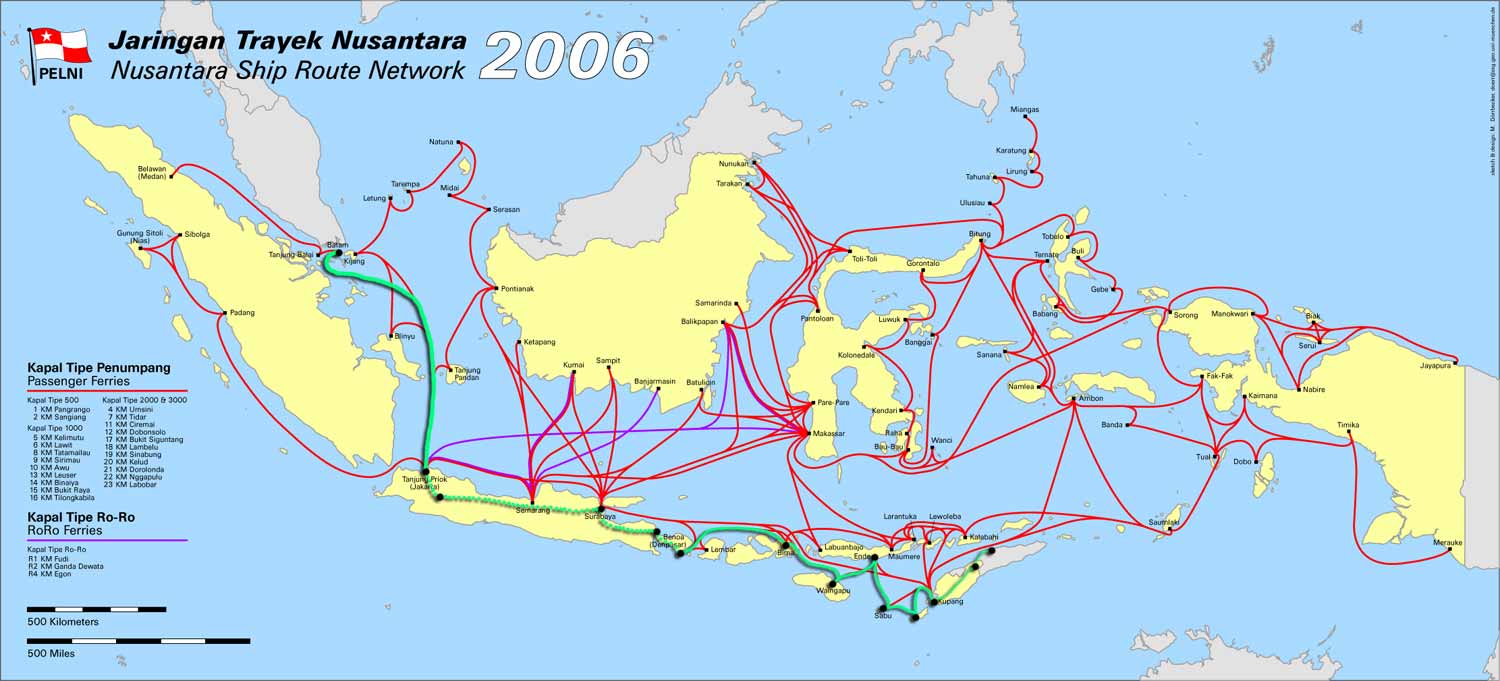
Pelni is the Indonesian public ferry operator, who still offer most routes on the map above. Check your preferred route well in advance as ferries usually only run once a week or (in the Bali-Kupang route) once every 3 weeks. To find out when the next ferry is due, check the Pelni website, make sure to select the little union jack (although this will only change some of the words into English) and then select your start port and destination in the ‘Ship Departure Schedule Search’ (‘Pencarian Jadwal Keberangkatan Kapal’ if English isn’t working) in the middle on the left. Make sure to set the date range pretty wide to be able to capture these infrequent services in your search. Check preliminary availability and rough prices by clicking ‘fare table’.
Note that you sometimes have to have a crystal ball to know what your destination port is called, as it’s not always the same as the city name. For example, if you want to arrive in Bali, don’t look for ‘Bali’ or ‘Denpasar’, you need to look for ‘Benoa’. If you’re choosing a different route to the one we’re describing, you may have to do a little bit of detective work on google. It was possible to find out about schedules via phone ( +62 (0)21 791 80 606), but not find out what different classes included or to book tickets, which we were only able to get from the local offices. But more of that later.
So here you have it: the Rat & Dragon step by step guide to travelling overland from Singapore to Timor and beyond. All prices at time of writing, i.e. June/July 2014. DISCLAIMER: We would love you to have the best holiday in the world, so please always check these details locally as embarkation locations may change randomly (this is Indonesia, remember!). Otherwise, enjoy!
Singapore to Jakarta: Pelni Ferry
1) Ferry Singapore (Harbourfront) to Batam (Sekupang), 1 hour, SGD 35 pp

Take the underground to Harbourfront, fight your way through the endless maze of Gucci, Prada, Tiffany’s and Davidoff to the ferry terminal. Acquire ticket to Batam (Sekupang) on the 3rd level of the ferry terminal (there are various companies offering several crossings a day to different ports, make sure to chose Sekupang) and resist the temptation to pick up a special promotion Samsonite trolly suitcase from the stand in the middle of the terminal. Board the ferry, it should look something like this:
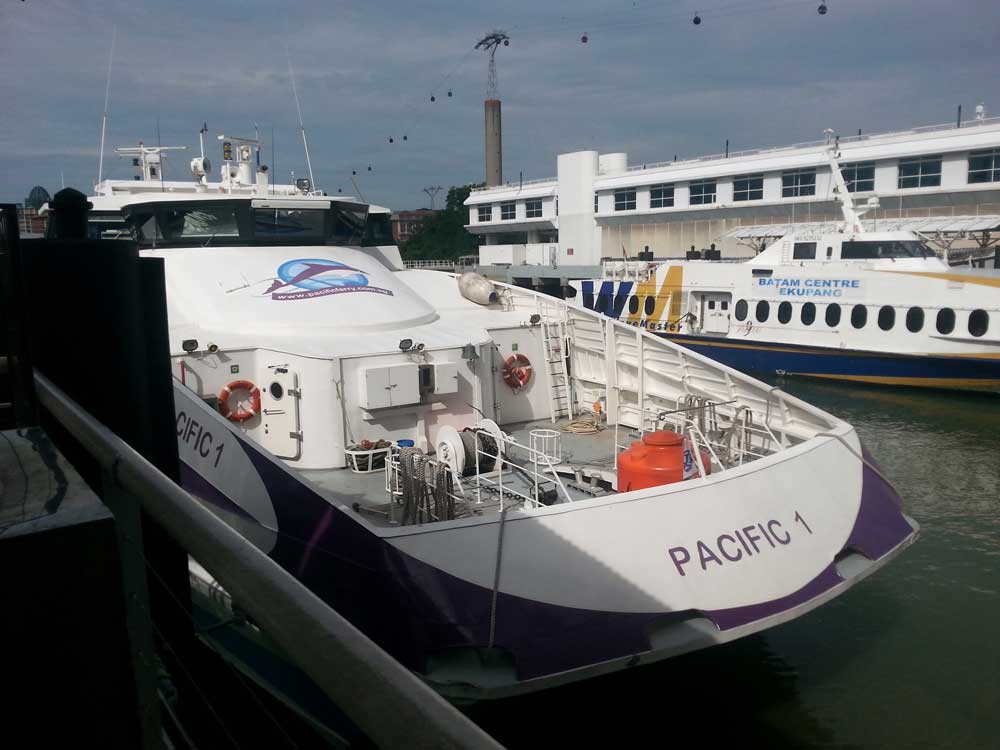
Congratulations, you have arrived on Batam Island, (the port is called Sekupang – we’ll put the port name behind the place name, if different, in parenthesis from now on) and in one hour have made it from Singapore to a completely new country: Indonesia. Give yourself a pat on the back.
2) Pelni ferry Batam (Pulau Batam) to Jakarta (Tanjung Priok), 30 hours, 2nd class: IDR 517’500 pp
Once on Batam Island, make sure you have enough cash (Pelni don’t do cards here, there’s an ATM in the terminal building), leave Sekupang terminal and head out to the road in search of the Pelni office. The address is on Jalan RE Martadinata – Jl. Dr. Cipto Mangunkusumo No.4, (Phone: 0778321070) but there are about 5 roads all called this. Here are pretty pictures in stead. Don’t be fooled by the google map windiness of the road, we found it to be quite straight and a little bit of a walk with the backpacks but certainly not worth getting ripped off by a persistent taxi driver at Sekupang terminal.
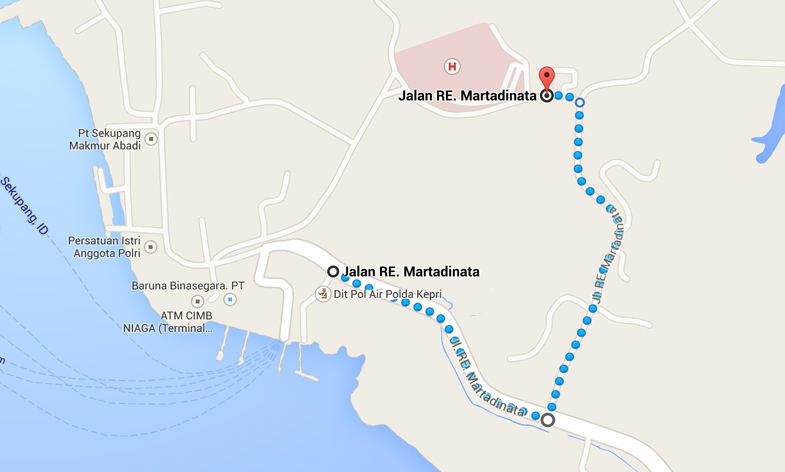
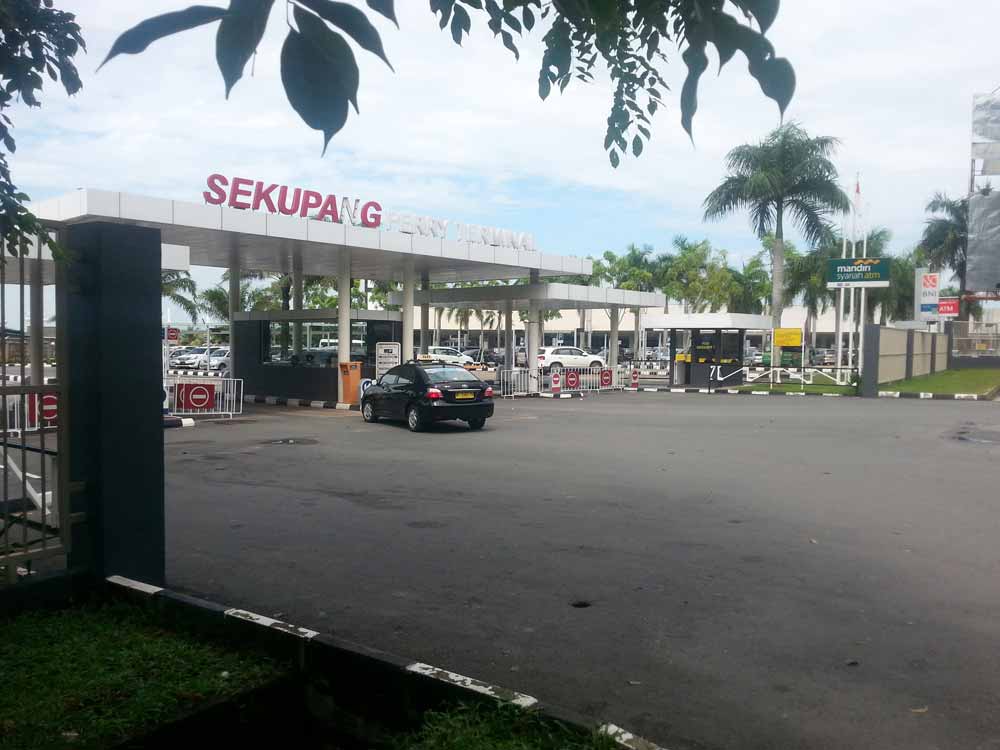
Turn right after heading out of Sekupang Terminal car park. Strike your best ‘I’m a tourist’ pose (no use denying it, you’ll never pass as a local)…
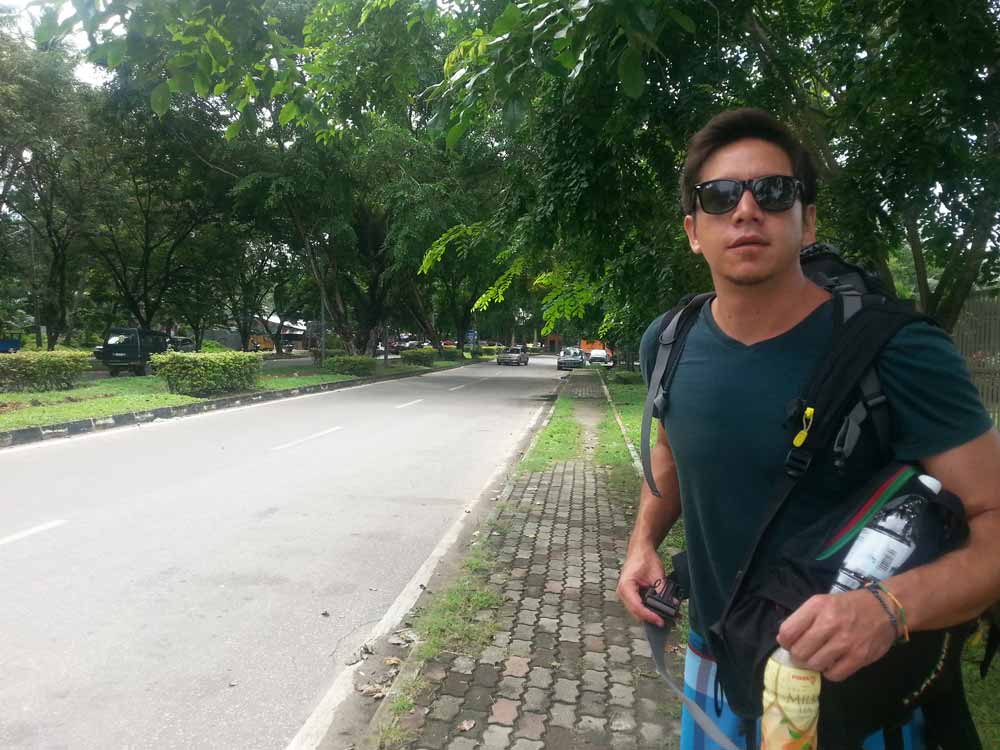
…and head down the road until you reach these old toll/security gates.
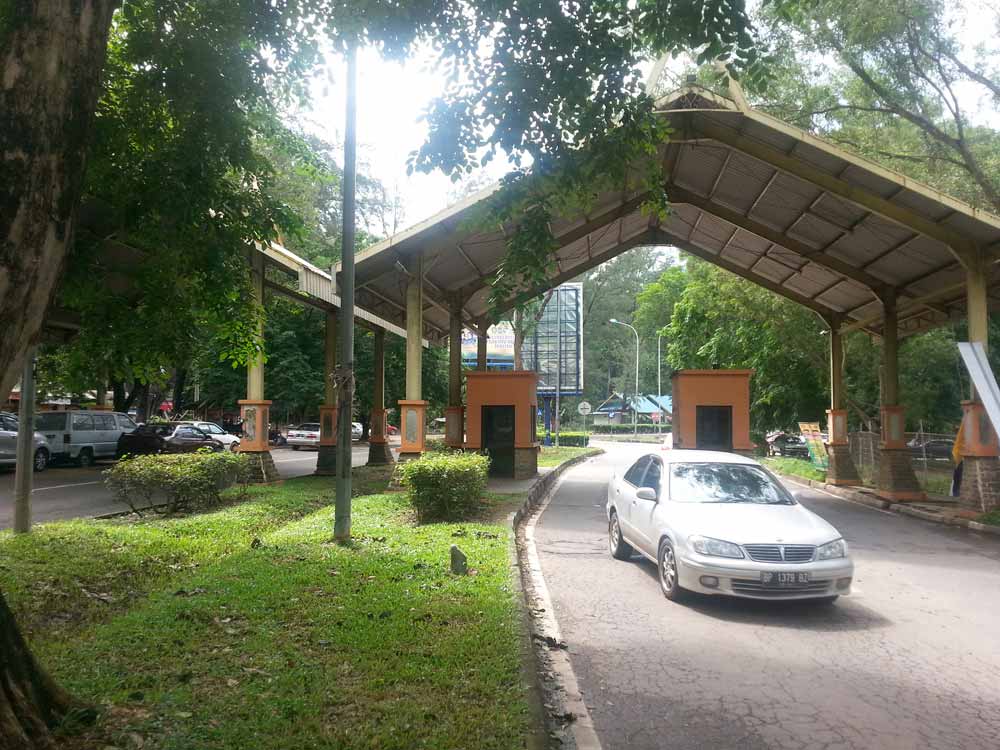
Turn left up the next road (it’s quite long, wide and empty), engage in banter with the taxi drivers hanging out on the corner but don’t believe them when they tell you it’s an hour’s walk to the Pelni office. It is not.
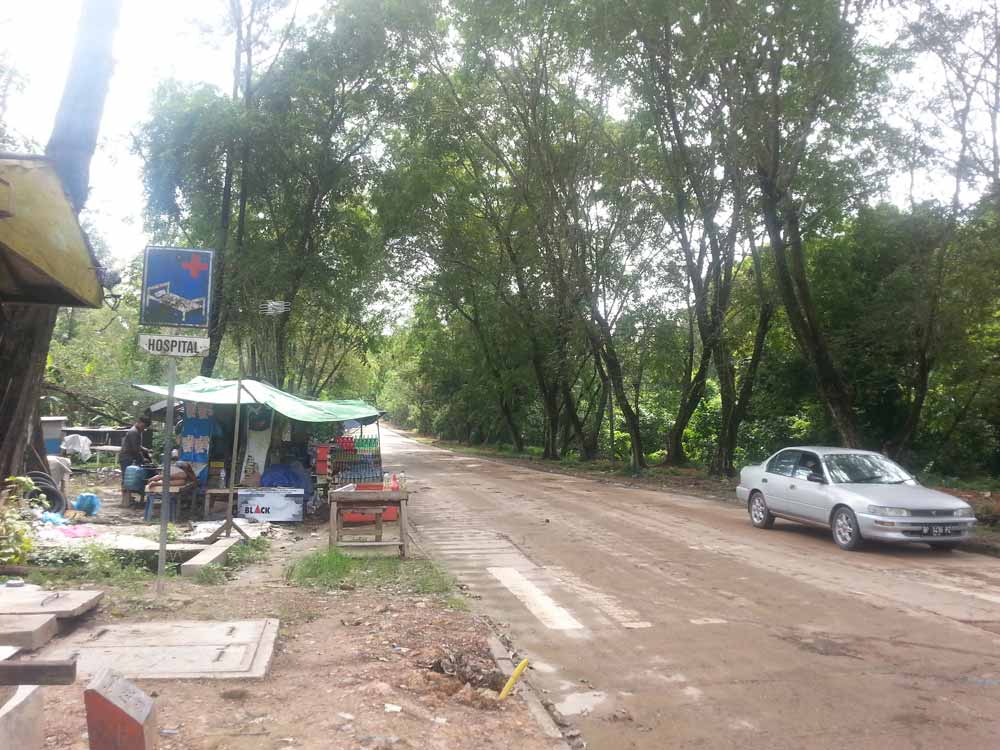
We wouldn’t recommend this particular hospital establishment, but get some water if you’re thirsty (check it’s still got plastic wrapping around the top). Head up this road…
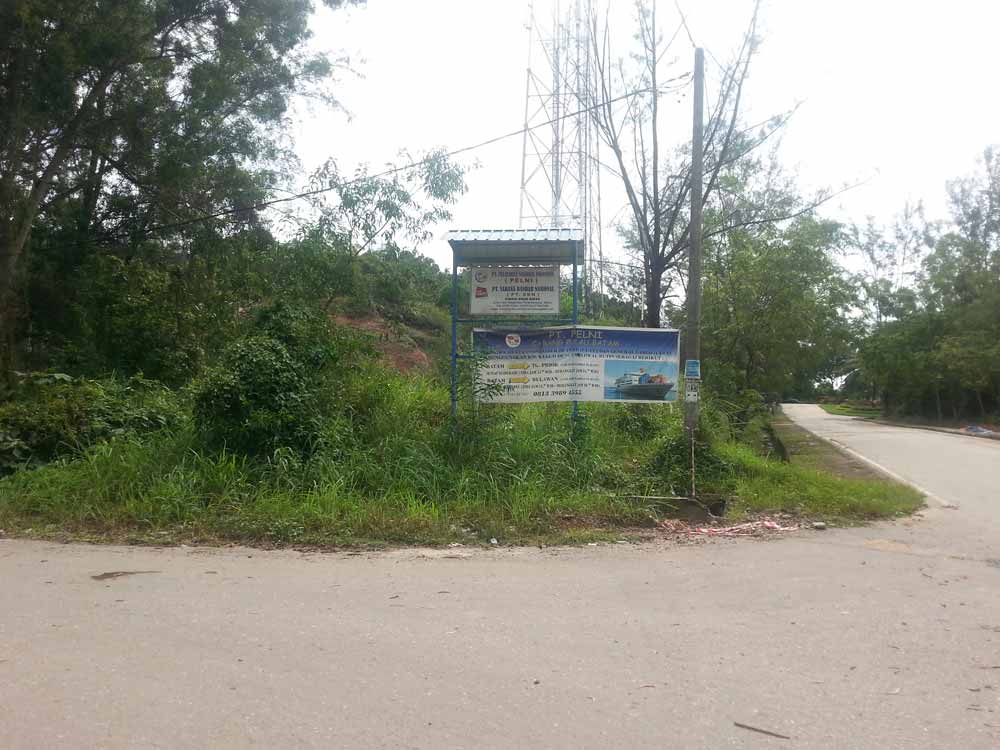
…until you get to a left turn. If you look closely, you’ll see this washed out Pelni sign at the junction. Turn onto this road.
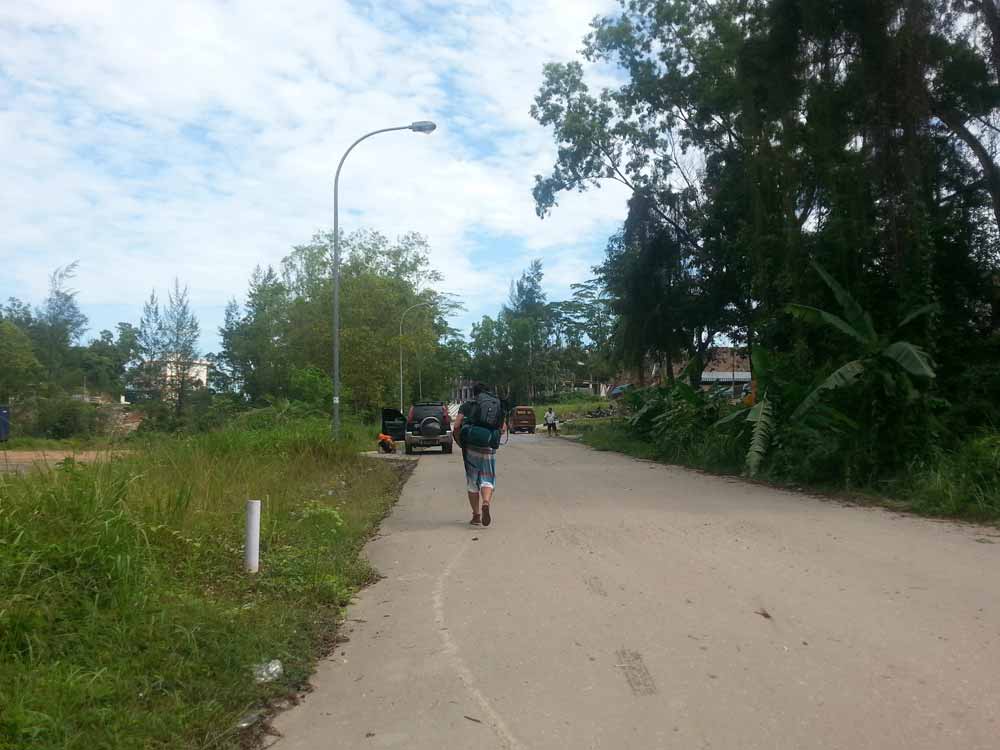
About 100m on your right, there will be a house with similar signage (you can see it peaking through the trees on the right of the picture above).
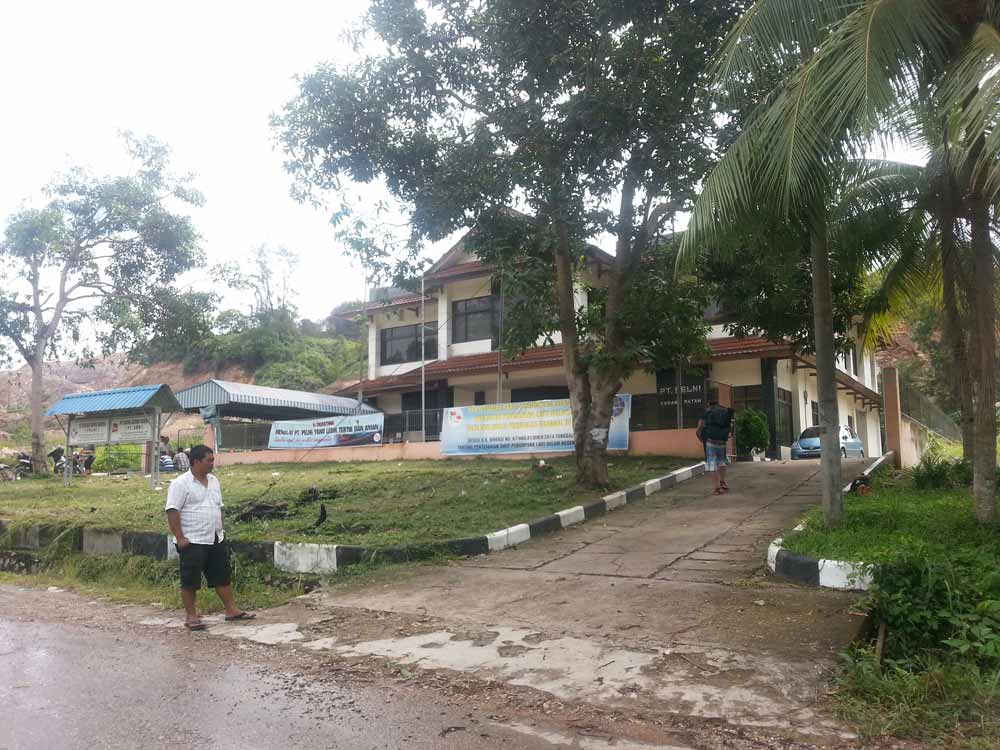
Engage in random banter with dude in white t-shirt. Then proceed to the blue and white striped awning and tell everyone in the queue you want to buy a ticket or you won’t be seen by the ticket vendor behind the grimy window. There was no way for us to buy tickets in advance or check their availability, so we had to take a leap of faith and just go very early on the day of departure and hope there were some left.
We got lucky and paid IDR 517’500 per person for a 2nd class berth, which is way cheaper than advertised on their website. Maybe our student IDs helped. 2nd class is gender segregated but we were around the corner from each other, sharing with 7 others per room (see pic later). Alternatives would have been a first class cabin each at IDR 1’628’000 (whether they let men and women share a cabin is up to the officer/captain on that day, we weren’t allowed to share) or economy class at IDR 415’000 which is a mattress space on the floor in a big room (or cardboard in the corridor/stairwell if you’re not fast enough – check out this blog for pics). Due to our need to lock up our kit, we chose the cabin, although for one night the ‘dorm’ would definitely have been an adventure.

Next step was heading to the Pulau Batam departure terminal and kill time until our scheduled departure at 5pm. Head back down to the Sekupang terminal you arrived at, thank the taxi dudes for their kind offers to rip you off earlier. In stead of going into the car park, keep straight on past it until the road curves to your right by a big white water tank.
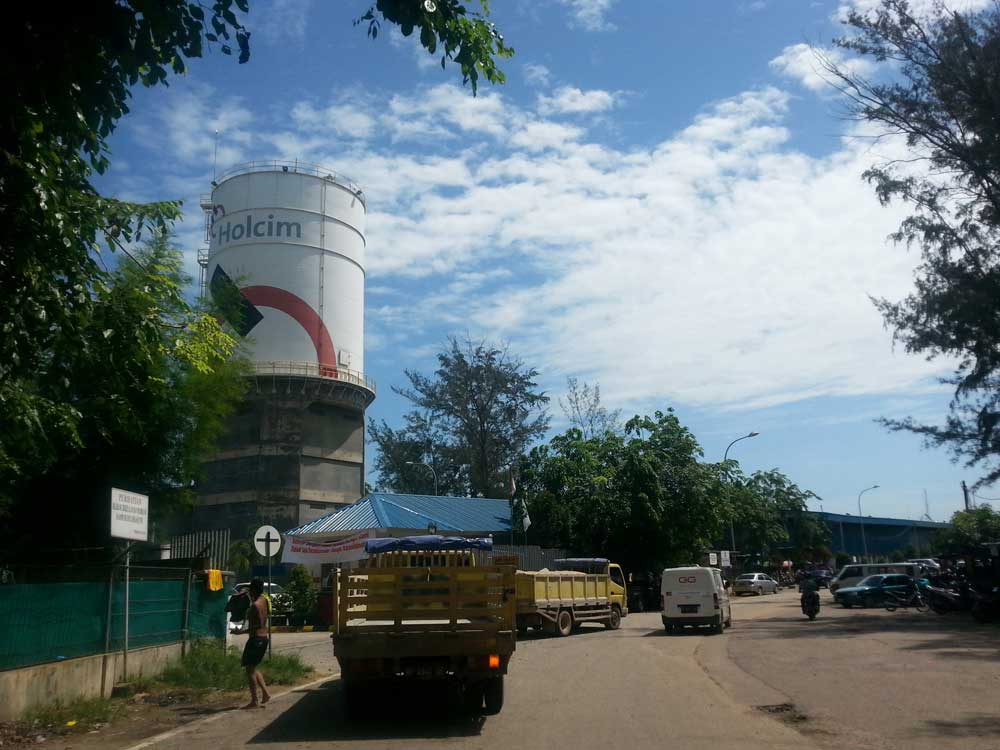
Keep going until you spot a large blue warehouse type building on your left (seen in the right hand corner of the pic above). This is the waiting area for Pelni’s ‘Pulau Batam’ – note it is ram-packed with people (yes, there are that many people waiting to get on a ferry with you).
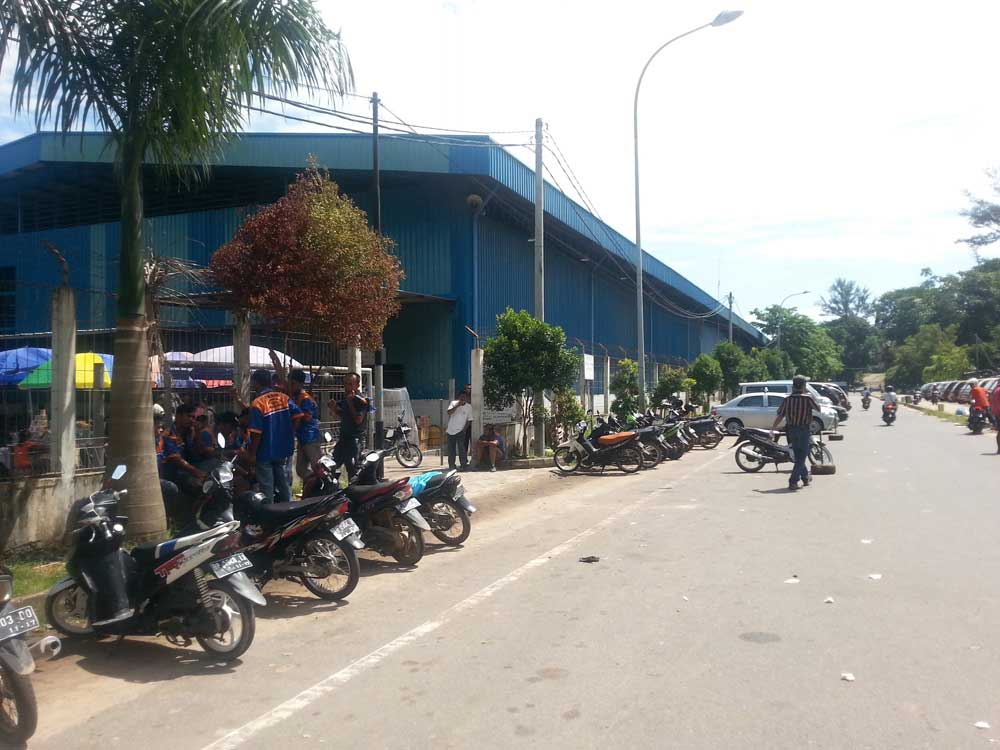
Enter past the guard, we chose to sit outdoors because it was a) pretty warm so everyone inside was sweating their proverbial bits off, b) the outdoors view was much nicer for the 8 hours we had ahead, c) no one was going anywhere for quite some time and d) there was a Bakso man playing twinkly music.
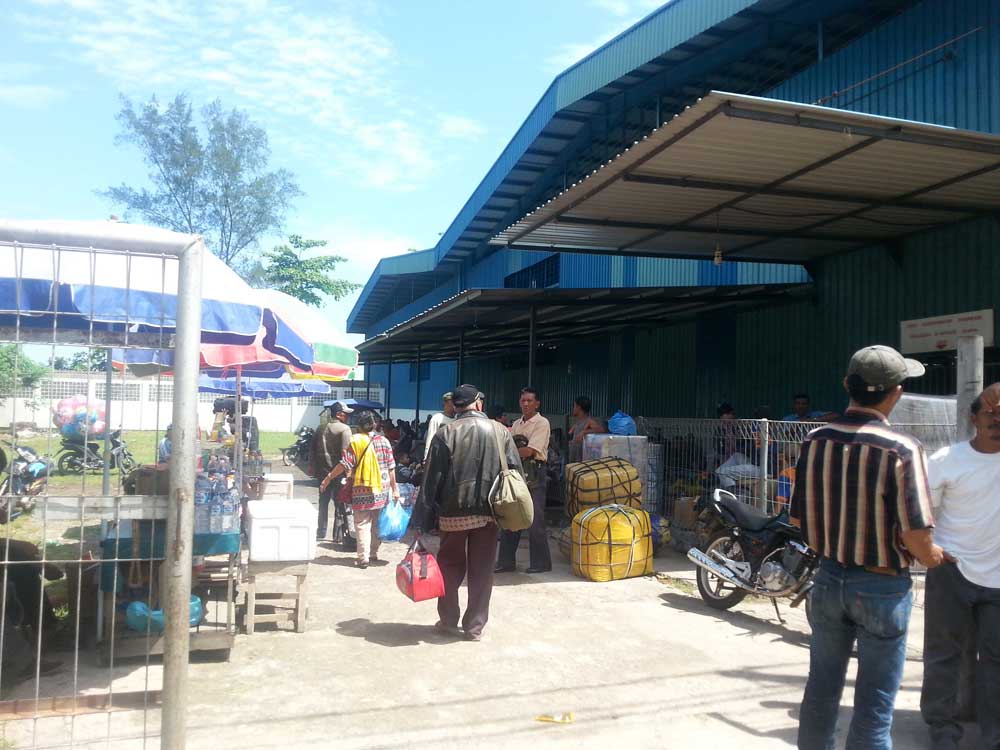
Purchase breakfast, lunch and snacks from ladies on the left. Purchase colourful bouncy ball that almost immediately deflates from scooter at the back. Wait. Send friend back to Sekupang terminal to buy cold water and Indonesian SIM cards. We found SIMpati good – vendors will usually charge you a service fee made up on the spot, so for IDR 10’000 credit, you’ll have to pay 12’000 and so on. You can get blocks of 1 week unlimited mobile data though, which is fantastic as we used our phones as mobile tethering hotspots so were able to do a lot of work on our laptops. Get the vendor to set it up, they may need to download some software, and credit needs to be allocated especially to internet usage. Make sure it works before leaving the shop. Wait some more.
Finally around 5pm, we were funnelled through the warehouse down a very narrow walkway area at the back and out to the harbour. Everyone made a game out of seeing how far they could push, or if they could queue-jump by legging it over the razor wired pier gate. Varying degrees of raucous laughter ensued. Prepare to be squashed.
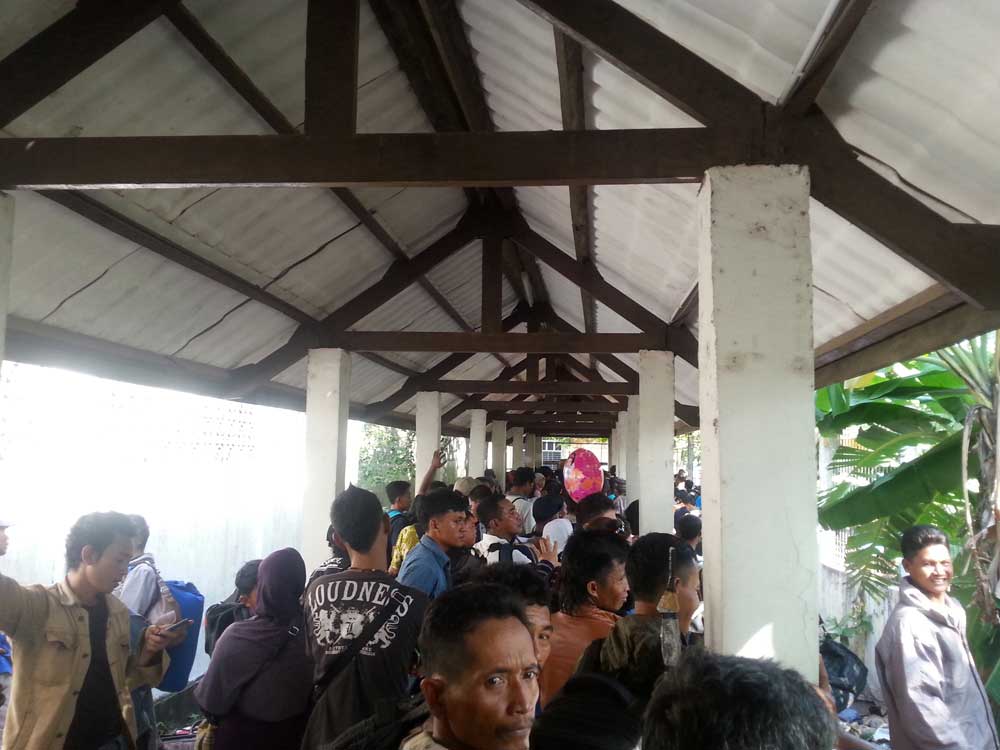
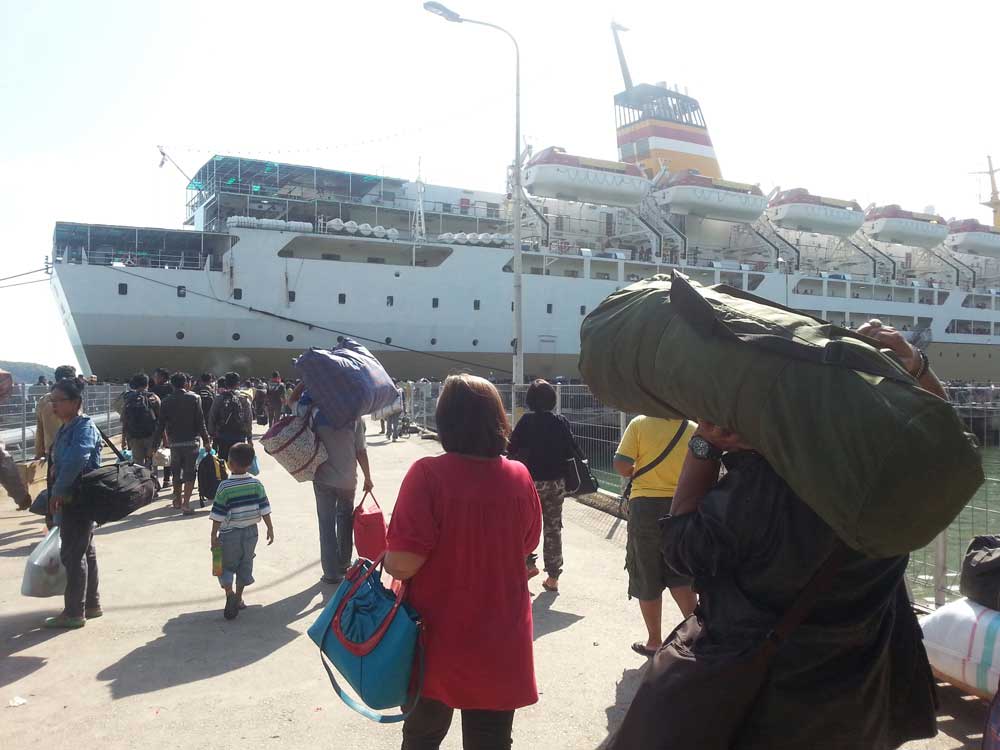
OUR BOAT!!
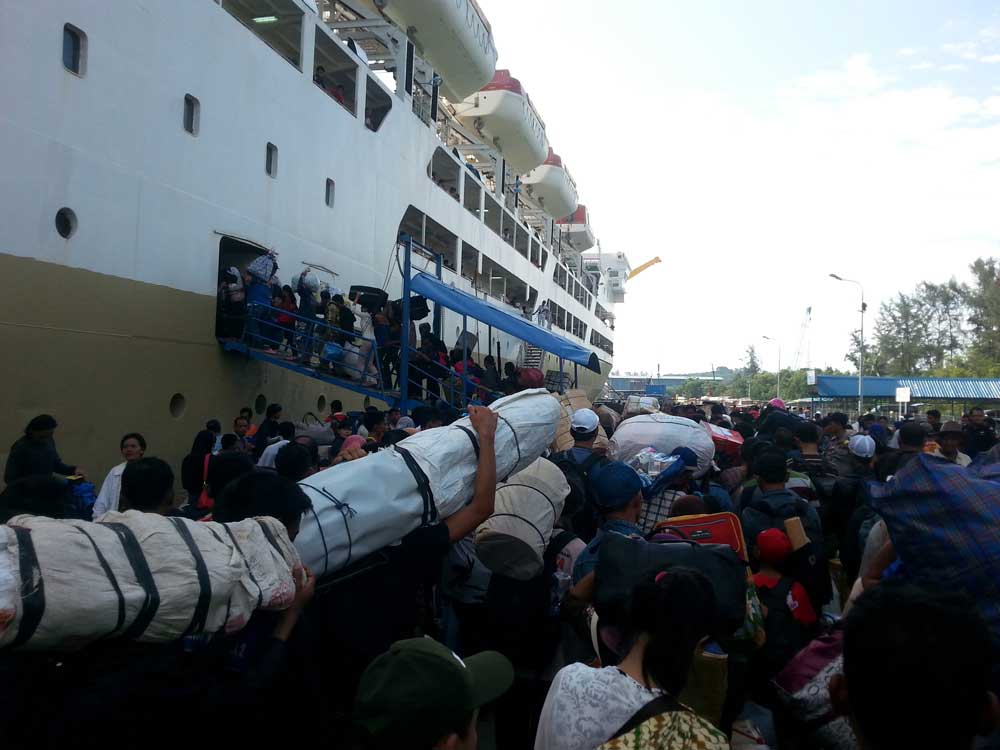
Added fun-factor by the boat: a) try to not miss the gangplank whilst being squeezed around and out of the throng, b) try to not fall in the water. Think of the whole thing as a mass-hug.

One of our rooms before everyone else got there. Ask the ferry reception for a bed with a lockable locker (only half the beds have them) and most beds didn’t have blankets, so we improvised. It was quite crowded once all beds were full, but otherwise a lot more luxurious than expected.

Make instant friends on deck and have a look around before everyone takes up all the space with makeshift beds on every available floor space. The family sleeping, cooking and generally living in the little corridor in front of the fire escape were very keen to practice their English. There is an open air bar/cafe at the back of the ferry where cheeky teenagers will comment on everything you do, say and wear.
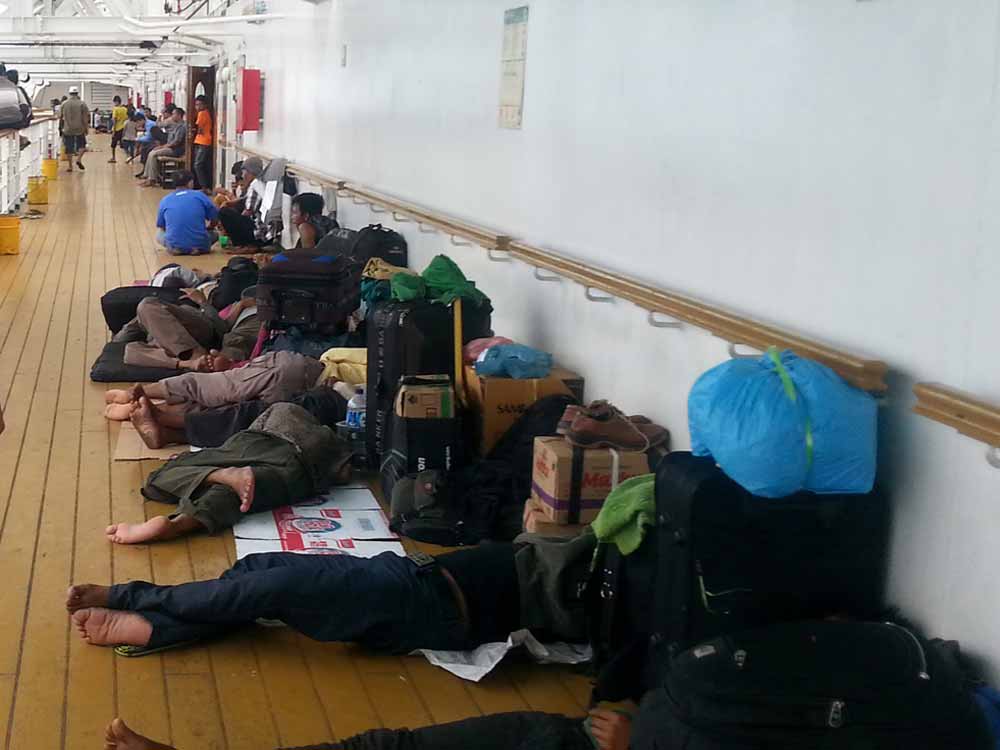
Economy latecomers claiming their little piece of floor space for the night.
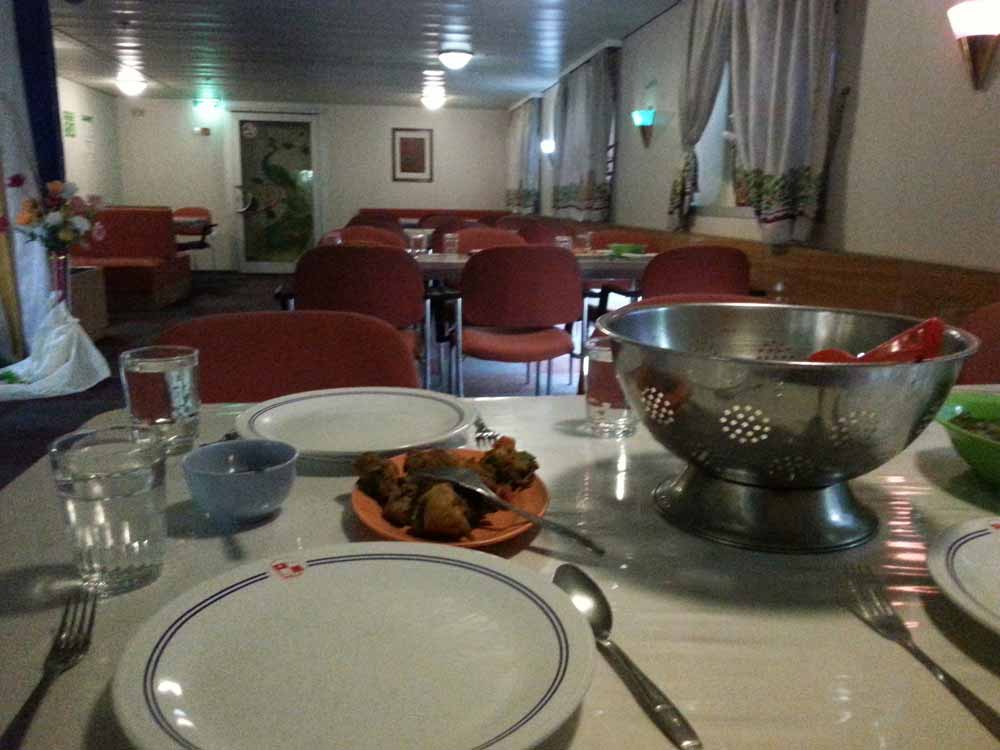
2nd and 1st class are fed at 6pm, usually fried fish, chicken, unidentifiable boiled vegetables and rice. On special occasions, a band made up of the pump mechanic, kitchen help, second level steward and captain’s niece in a D&G hijab and sparkly dress will pelt out 1970s Indonesian pop classics at full volume next to your table. For some things, there is mastercard – the good things in life are priceless.
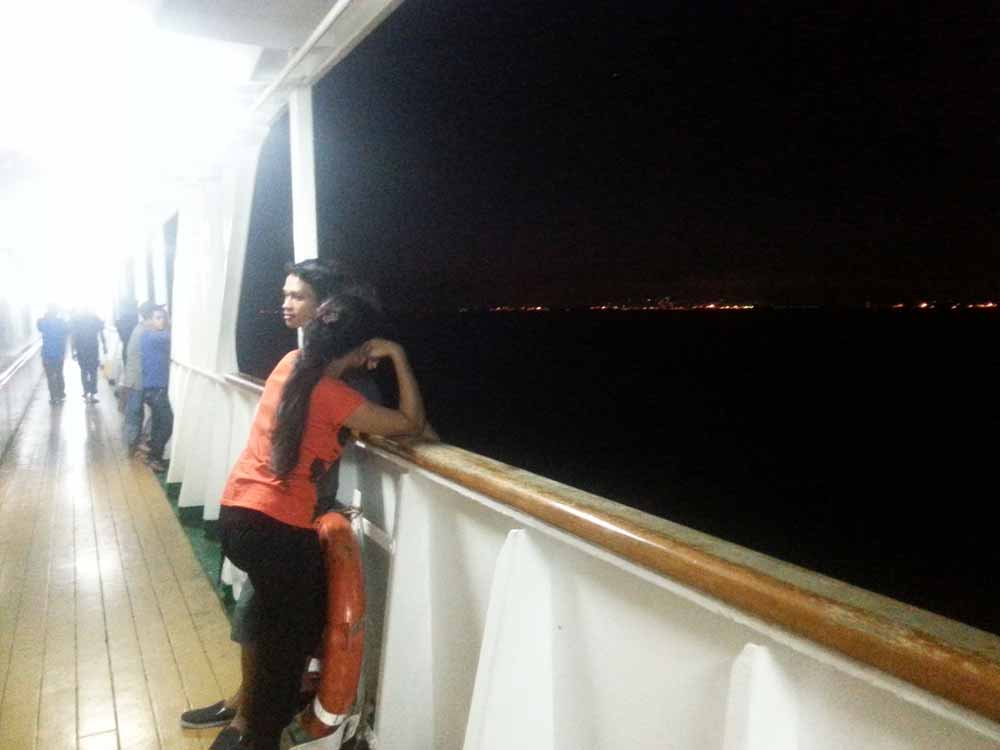
Finally at 1am, 8 hours after schedule and 16 hours after we got out tickets, the ferry left Sekupang and couples had the romantic opportunity to enjoy the view over Singapore’s multi-billion dollar lit architecture, from the comfort of their cardboard cushioned sleeping sarongs before bunkering down for a night of sea breeze on deck.
We arrived the following night at Tanjung Priok (see below) around 1am and called a Blue Bird taxi (24 hour service) to take us to our hostel in the centre of town (about 45 mins drive away. We wouldn’t recommend walking). Whenever you need a cab in Indonesia, call a blue bird. When calling, make sure to call the correct office – Jakarta: (021) 79171234/7941234, Bali: (0361) 701111, Lombok: (0370) 627000 etc. as Indo taxis aren’t amphibious (yet). They also have a smartphone app for easy booking in Indonesia.
Note that NOT all blue taxis are blue bird taxis. Taxis that are marked ‘blue group’ are also NOT blue bird taxis. There are countless stories of other cabs either making you pay ridiculous amounts of money, having no idea where they are going, arguing over already confirmed fees or putting people into seriously dodgy situations. Whilst we never had a bad experience with a cab, Blue Bird were the most reliable, easiest to deal with and friendliest drivers we met, and always put us on the meter.
Chill out in Jakarta for a desired period of time.
Jakarta to Bali: Train, Train, Train, Rickshaw, Ferry, Bus
1) Train Jakarta (Gambir Station) to Bandung, 3 hours, Executive Class: IDR 100’000 pp (IDR 130’000 pp through travel agent)
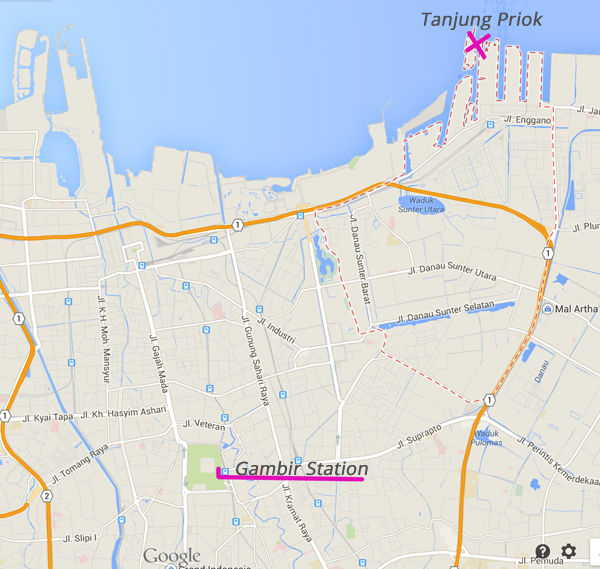
Transport from Jakarta to Denpasar (Bali) is usually a straightforward all-in-one ticket comprising a train to Surabaya and Bayuwangi, a ferry to Bali and bus to Denpasar. All sorts of very helpful info can be found on Seat 61.
We were unfortunately not quite as lucky as trains, busses and dodgy minivans were booked out days in advance upon our arrival, which had something to do with this holy time of the year for certain countries… oh, yes, Ramadan. If you find yourself in a pickle, worry not as a local travel agent who managed to work through his bosses completely illogical chatter and presented us with a solution – a similar route, but with more exciting stop offs. Read on and experience the wonders of the Indonesian rail network.
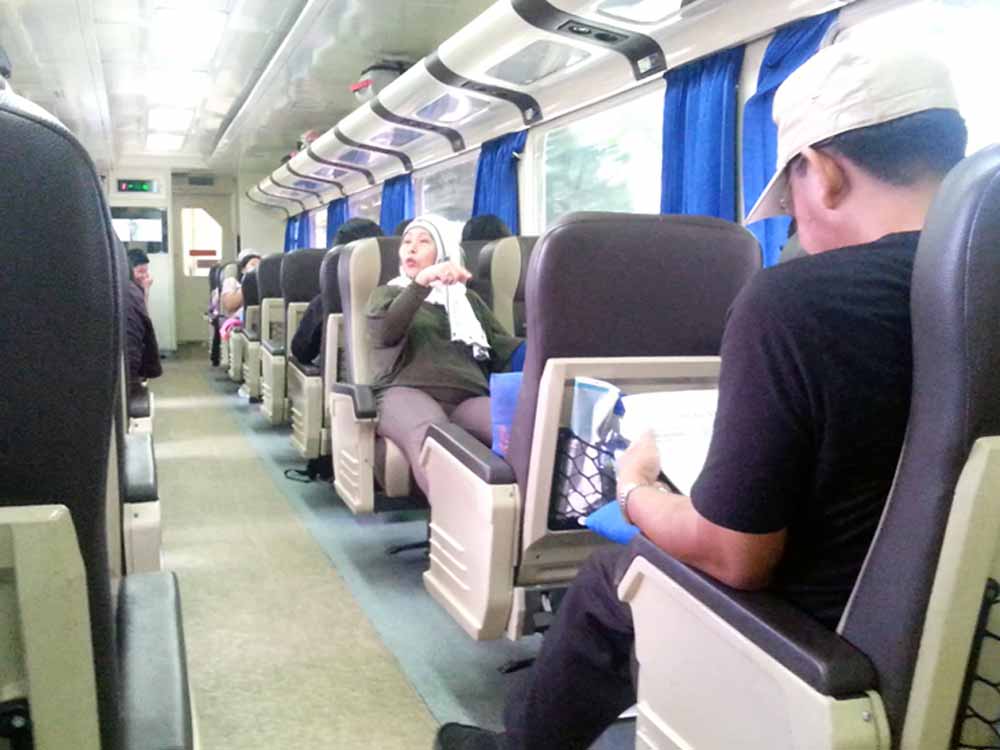
Board train at Gambir Station, headed for creative Javan hotspot Bandung. Note that the seats swivel like the Japanese Bullet Train models so you can face your new found friends or travel backwards if you’re into rowing.
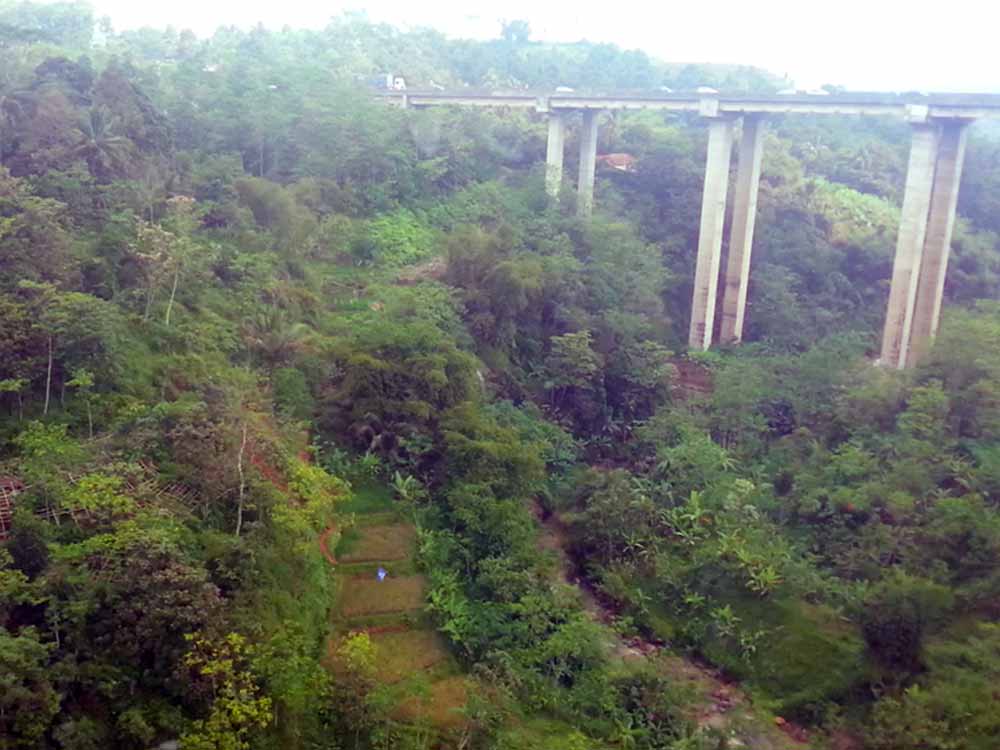
Enjoy the beautiful scenery along the way. Don’t drop your camera out of the window.
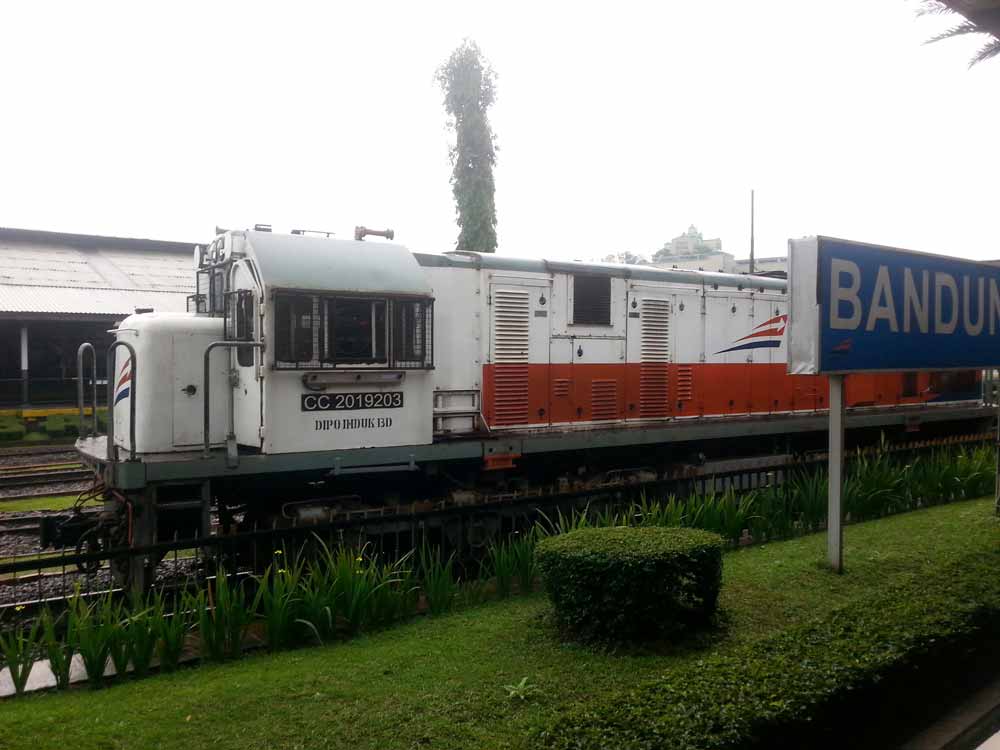
Upon arrival in Bandung, take lots of childish photos blocking out half of the welcome sign. Enjoy the really very good band playing for free in the passenger seating area. Go buy lunch at the japanese fast food place, walk back past the band and realise they’re all blind. Your mind may blow.
Go crazy in Bandung for a desired amount of time.
2) Train Bandung to Surabaya, 14 hours (overnight), Business Class: IDR 365’000 pp (IDR 395’000 pp through travel agent)
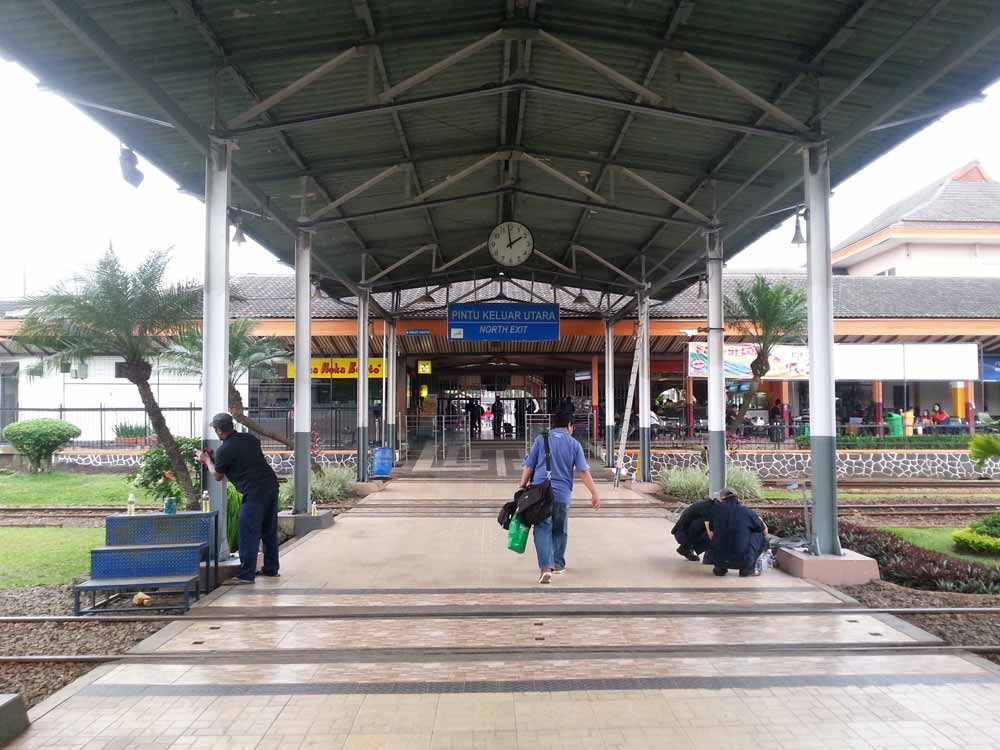
Once you’re ready to leave the trendy crowd of Bandung behind in search of your next exciting destination, head over to the tracks past the station’s immaculately kept gardens. Ask an attendant to point you towards your train as they sometimes park one in front of the other which makes it difficult to tell them apart.
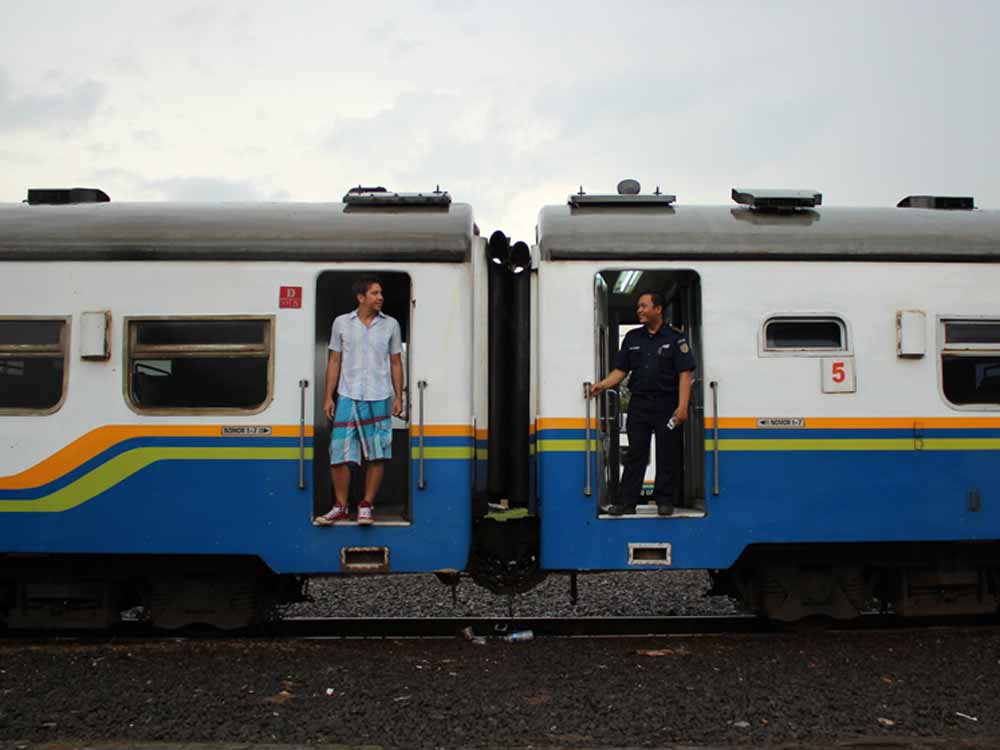
Walk way beyond the platform if need be, there will be wooden steps from time to time to help the less agile into their designated carriages. Do a Saxon in your carriage and chat with a conductor in a mutually made up sign language.
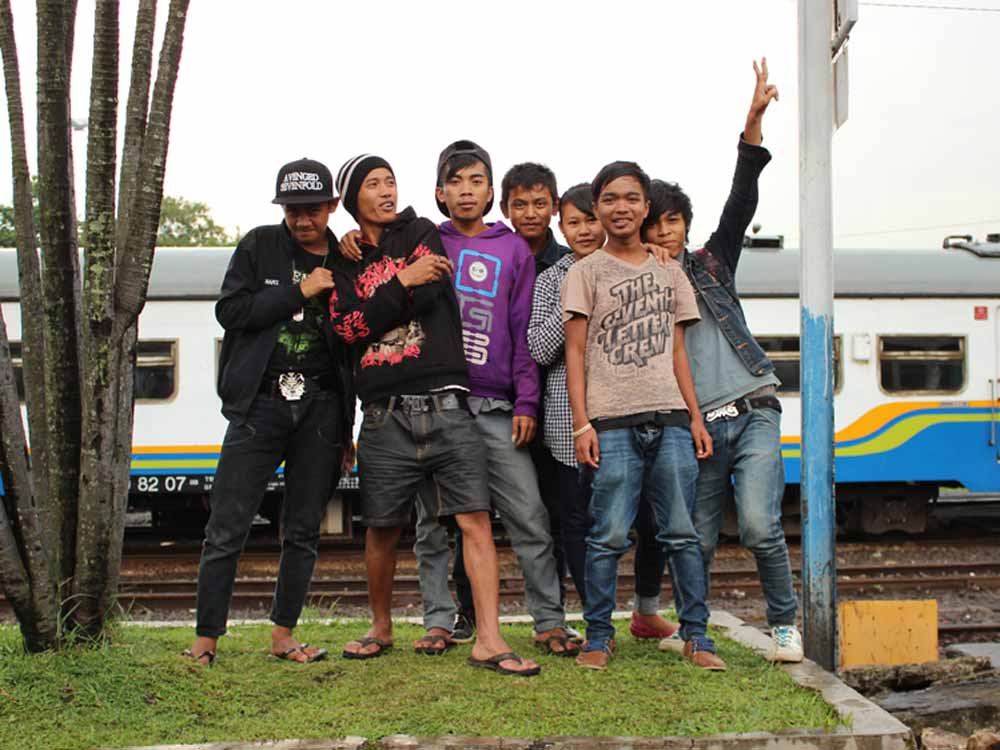
Local kids are also more than happy to pose for your camera. If you’re lucky you’ll see some of them train-surfing later.

Business class doesn’t have reclining seats, but we found the benches a lot easier to sleep on, provided you like the person next to you. Pillows are also provided, but collected early in the morning so get comfortable sooner rather than later.
3) Train Surabaya to Banyuwangi, 4 hours , Executive Class: IDR 255’000 pp combined train, ferry and bus ticket to Denpasar (IDR 285’000 pp through travel agent)
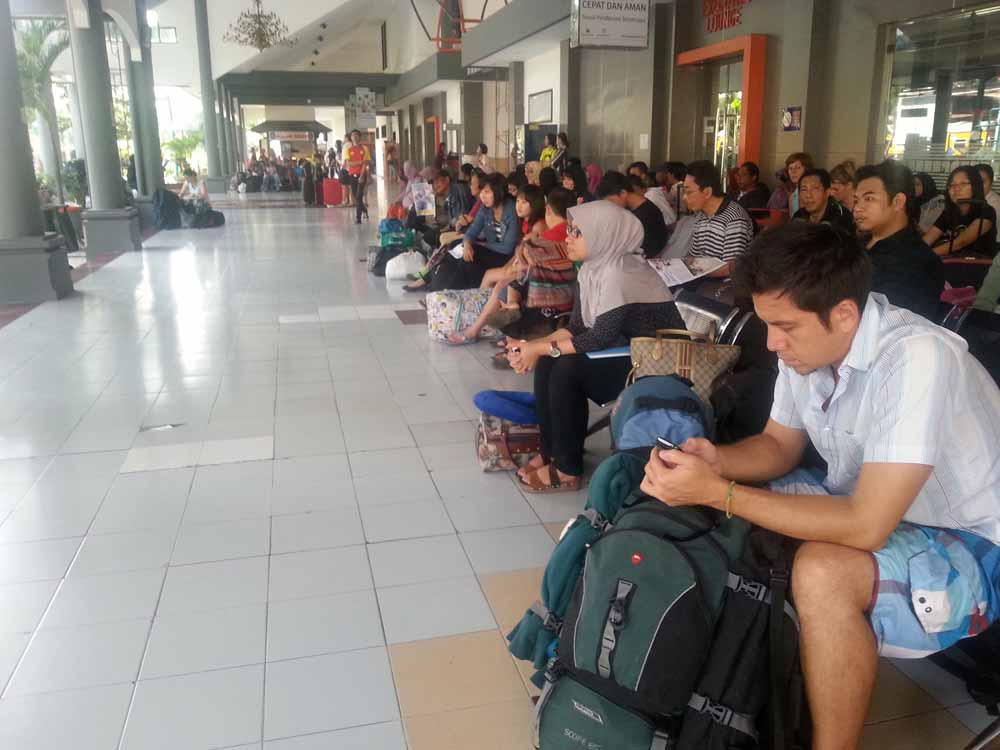
Get woken up way too early by the conductor taking your pillow. If you leave the waiting area or the Surabaya station, you are not allowed in again until an hour before your next train. If you do have to leave the station, there is a cafe confusingly called ‘VIP lounge’ in the main station building that is more comfortable than the floor. Alternatively, check out Surabaya’s statue of a shark fighting a croc in the city zoo. It might inspire you to chill for a while and postpone Bali plans.
Connected interesting fact of the day: Indonesia’s second largest city is locally believed to derive its name from ‘Suro’ (shark) and ‘Boyo’ (croc) who, according to myth fought for the title of strongest animal. The Aussies have a slightly more pragmatic take on the matter of animals, which you can read all about here.
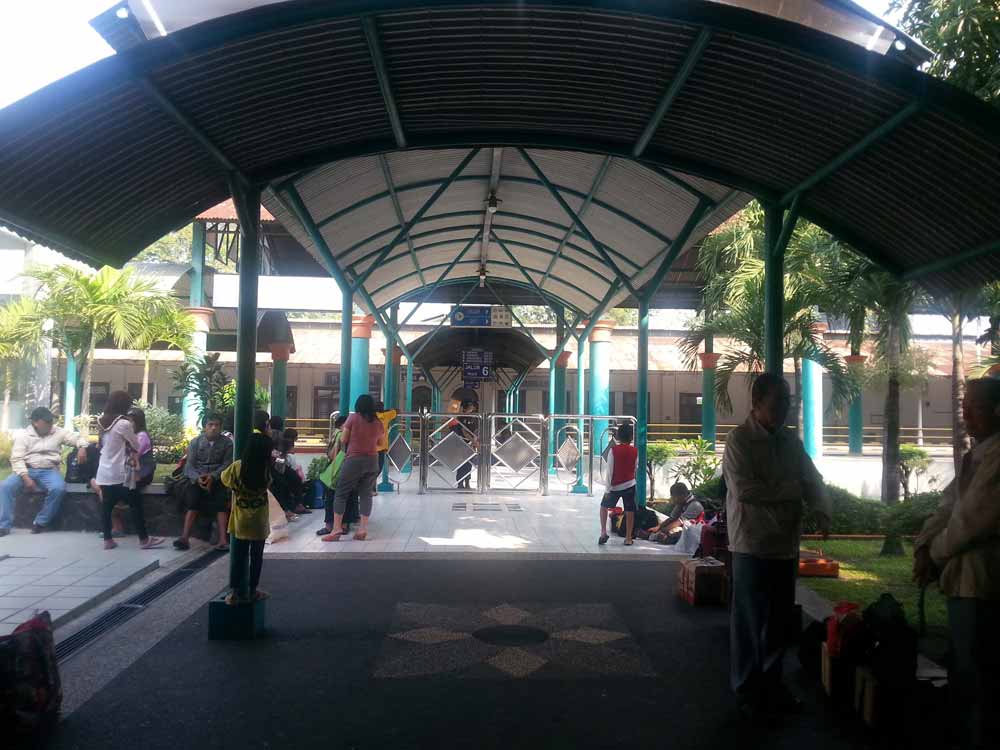
Be entertained by yet another X factor worthy head-scarfed girl-and-piano combo singing beautifully in the waiting area. When the train is ready, ask an attendant for confirmation (avoid heading with the flow, we nearly got sent back to Bandung by accident).
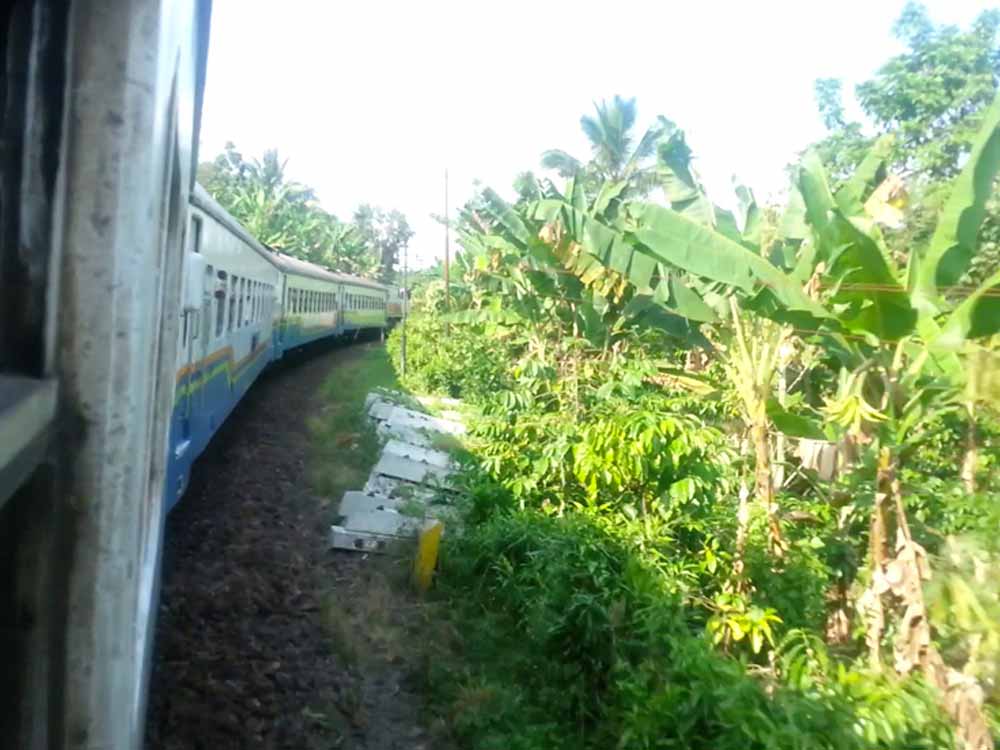
Seats are similar to the Executive Jakarta to Bandung service, but a lot more threadbare and lumpy. We missed our Business Bench, but the views on the way were fantastic.
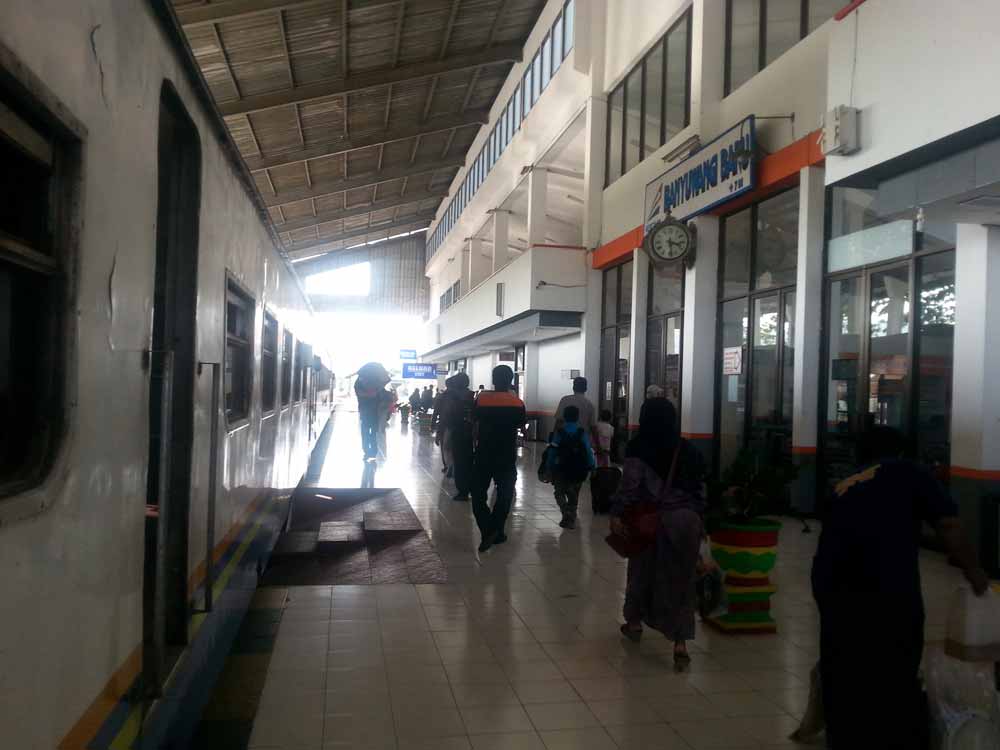
Arrive in Banyuwangi, everyone disappears. Get a bakso, get your ticket taken off you by some dude who tells you to wait for a rickshaw to the port. You have two options.
Option 1: Let loose in Banyuwangi (that already sounds like an awesome story). Option 2: read on.
4) Rickshaw from Banyuwangi train station to ferry port Ketapang, 10 minutes , included in price if you manage to avoid paying a large tip.
Photographic evidence of this thrilling rickshaw ride is far too blurry due to high-speed inter-lane highway travel. It was kind of like Star Wars Pod Racing. You’ll just have to use your imagination.
5) Ferry from Banyuwangi (Ketapang) to Bali (Gilimanuk), 1.5 hours, included in price if you track down the dude who is looking after your ticket for you.
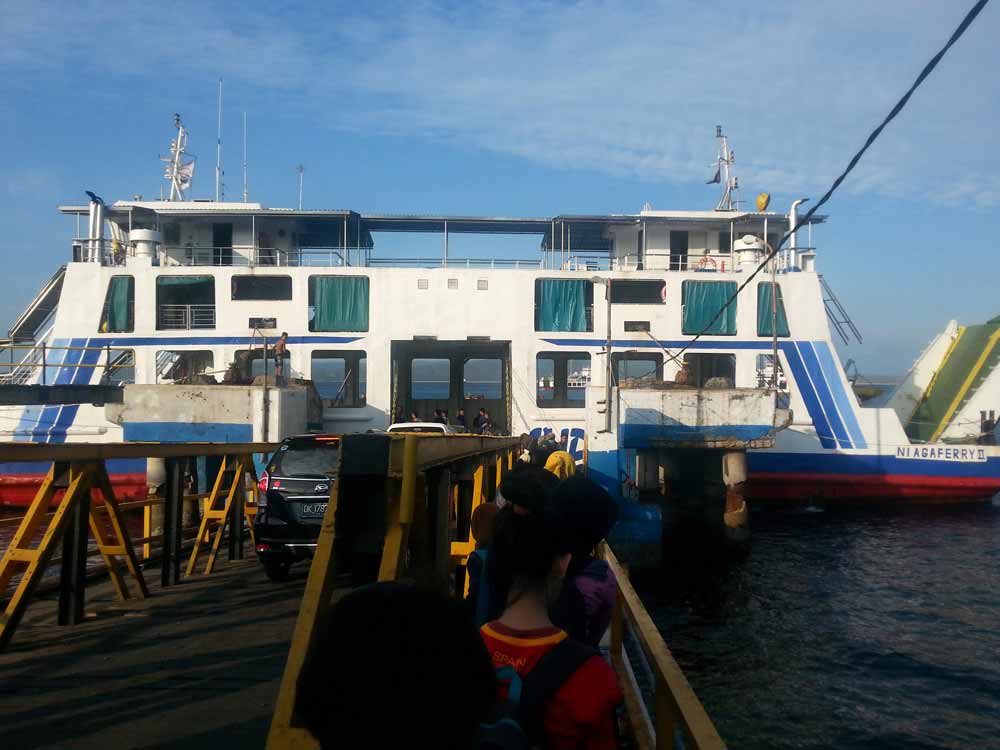
Ferries operate so regularly between Banyuwangi (Ketapang) and Bali (Gilimanuk) that a crossing that should take half an hour is so overloaded with operators that ferries have to wait in a queue for an additional hour before being able to dock at port. The crossing is over a very deep and open ocean like body of water, which means Bali is home to spectacular wildlife including Giant Manta Rays you can swim with at Nusa Lembongan. The crossing is sometimes a little rocky, but usually fine.
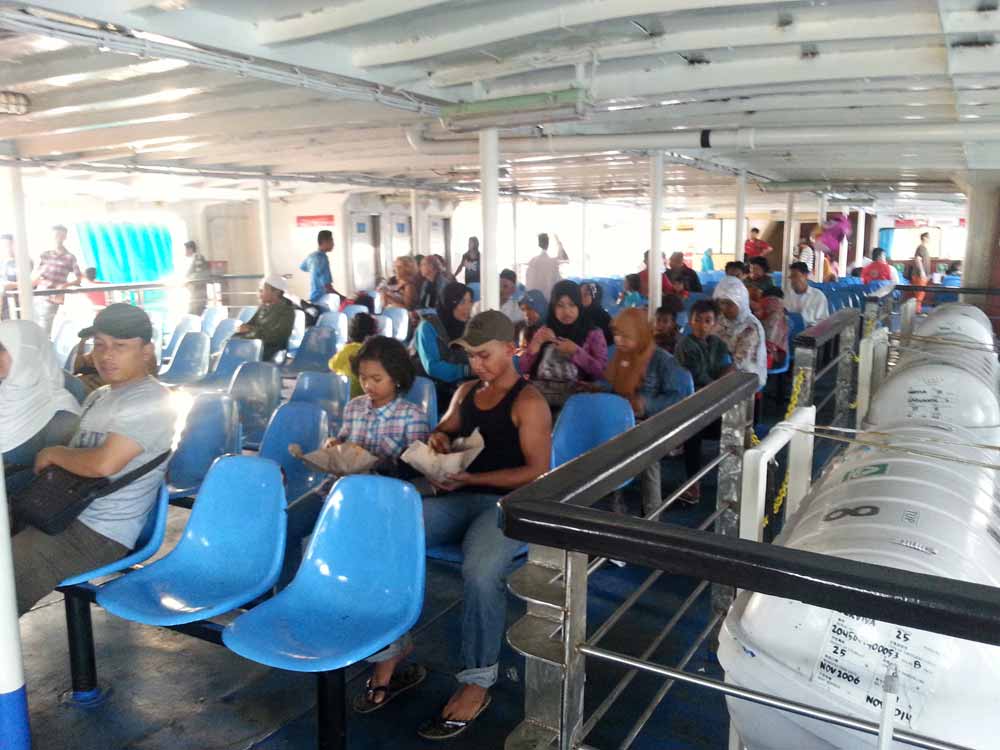
Some ferries have indoor areas, some, like ours, open deck seating where you can enjoy VHS tapes of trained monkeys on leashes doing tricks on a miniature bicycle to stupid music in exchange for booze. Cue an open mind and appreciation for unusual cultural differences. There is a little kiosk selling snacks – the home made potato fritters are fantastic.
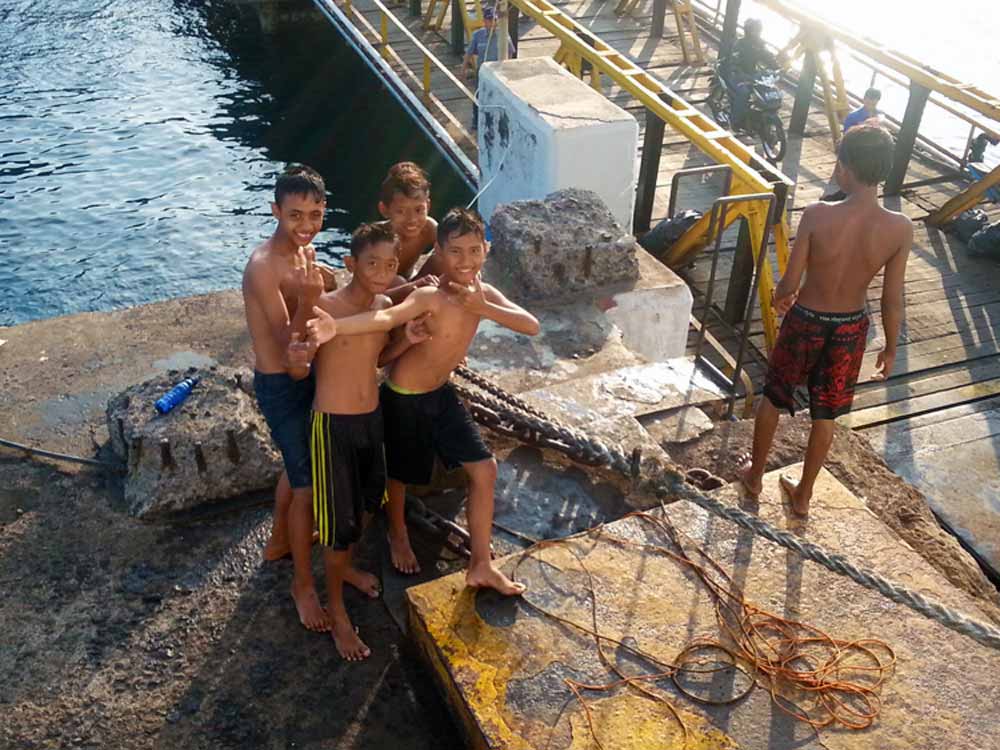
If you’d rather leave the entertainment up to local kids (and some daredevil grownups), these guys will jump in the water from very high and jagged places (including the top deck of the ferry) to catch coins thrown into the water by passengers who want to see the most spectacular jump. They swim back to the sometimes already moving boat, climb aboard and repeat. Raucous laughter included.
6) Bus from Bali (Gilimanuk) to Denpasar, 4 – 8 hours, included in price if you track down the dude who is hopefully still looking after your ticket for you and hasn’t buggered off to the pub/warung in stead.
So boring it didn’t even merrit a picture, the standard tourist minibus from the port to downtown Denpasar will take from 4 to 8 hours, depending on traffic and may stop off for dinner on the way (depending on the whims of the driver). When asked where we wanted to be dropped off, the driver pretended he knew anywhere else than tourist trap Kuta, which resulted in him driving us around the block three times and claiming it was upmarket tourist trap Seminyak. Thankfully our trusty Blue Bird taxi was with us 15 minutes after calling the Bali office on our SIMpati mobiles. WELCOME TO BALI!
We’re beyond interested to hear your stories from travelling through Indonesia, do share them in the comments. For the more eastward bound, don’t miss PART 2 of our Indonesia overland travel account: Bali to Timor.
All, Learn
Ever wanted a real filmmaking adventure? Exotic tropical travel, danger, beauty and glory? Well this could be your next project, but first, a word of warning: Rat & Dragon will not be responsible for injury, death or worse – kit damage – caused by attempting the following. (Although we’ll totally claim the credit for any epic surf footage you score). Read on and get inspired, and hell yeah – get out there and do it – but don’t say we didn’t warn you…
A small and beautiful island rises up from some of the deepest seas on earth. It’s a type of paradise, and it’s called Nusa Lembongan. It lies about halfway between the iconic islands of Bali and Lombok in the middle of the treacherous, whirling Lombok Strait. One particular beach on this island is fringed on its landward side by a small fishing and seaweed-farming village, and on its seaward side by a wide, coral reef lagoon. The outer edge of the reef is colourful, jagged and teaming with sea life, and it points into the direction of a sumptuous ground swell – oceanic waves that have travelled the surface of the Indian Ocean, uninterrupted, from as far away as Antarctica, before colliding with the Indonesian Archipelago.
Where this reef and this groundswell come together, something quite incredible happens. Wind direction, tide, swell and the shape and depth-profile of the reef conspire to create a powerful, hydrodynamic min-miracle – a near-perfect surf break – which barrels down the reef edge in flawless, fleeting slabs of hollow, crystal-clear Indian Ocean. Surfers call this type of mini-miracle a right hand reef break and named it Lacerations because that’s what happens when you surf it. The power of the waves as they thunder into the razor sharp coral simply shreds skin like grated cheese if you’re in the impact zone.
Aside from the danger in it, there is nothing short of unsurpassable beauty too. To a surfer, the scene is heaven – an opportunity to ride perfect waves, to feel like you’ve tuned into, and even mastered, the very nature of the universe itself inside a dynamic, hollow, seawater cavern as it rages around you.
To a filmmaker, it’s mind-blowing. There is sensational beauty in the motion of clear blue prisms as they contort into perfect forms. Tropical sunlight refracts inside, through and around ten thousand facets of seawater, in angles and directions that water can only exist in under tremendous forces, and never for more than a fraction of a millisecond, before it re-forms again and explodes. Add a surfer riding these perfect forms in sublime synchronicity, and surf filmmaking becomes a type of performance art of the highest order.
Filming surfers at Lacerations can be done in one of two ways. The safe option is from a pontoon anchored in the channel beside the breaking waves. You’ll need a boat to get yourself and your gear here, as it’s about 500m from the shore. Locals will take you on an outrigger for a dollar. Stash your kit in a quality dry bag and bring a dry towel. A zoom lens at 200mm and higher is a requirement for tight shots from this angle, and naturally a tripod or steadycam. The pontoon itself will of course be moving so keep this in mind.
The position of the pontoon is perfect for viewing right down the line – surfers will be riding directly towards you as the wave curls perfectly behind them, or closes around them completely. It’s like looking down the barrel, quite literally (a hollow wave is called a barrel – riding inside the hollow wave is “getting barrelled”). From here, on a clear day, Mt Agung, a massive volcano on neighbouring Bali, entirely dominates the skyline behind the action. It’s poetry of composition.
By far the most dynamic and engaging way of capturing surfers at Lacerations, however, is to get wet and swim out into the action. DO NOT ATTEMPT THIS UNLESS YOU ARE AN EXPERIENCED SURFER YOURSELF. As well as surf techniques, surfing “rules” and physical abilities surfers are likely to know or have, surf waves have readable predictability IF you know what you’re looking at. There are safe zones, currents, sections and rips that can keep you in the clear. Likewise, there are places you just never want to be caught in. Ever. So assuming you’re a surfer excited about shooting Lacerations, or you’re a strong, confident swimmer who plays by your own rules regardless of what any crazy Rat & Dragon says, or if you’re just keen to hear how we pulled this off, please read on.
You’ll obviously need a camera with waterproof housing. We simply used a GoPro on a “selfie” pole. Set to 60fps, 1080p, you can slow the action right down to get incredible images of tumbling, exploding, vertical and over-vertical water. For us, the real magic on screen came from filming from within the wave itself. Showing a fish’s-eye view of the surfer, crouched and speeding through a raging tunnel of water (getting barrelled) from inside the wave. The surfer is slotted inside a tube of crystal seawater, as if in command of his own twisted air bubble under the sea.
Shooting with a wide lens for optimum dynamic feel, you need to get as close as possible to the surfers. There’s countless inherent risks in this – not least that the surfer is moving at great speed on a sharp, pointy piece of fibreglass with sharpened, rigid fins on the back. He or she is also going to be at the most powerful part of the wave, only a split second or so away from the moment that part of the wave pitches over and smashes into the shallow, razor-sharp coral below.
To get in this position, you need to be just outside of the impact zone and directly down the line from the surfer’s take off point. There will be steady currents dragging you into the impact zone so you need to keep constantly swimming outwards. As a surfer approaches, hold your ground with camera rolling until the wave’s lip is almost pitching out over you. Dive down into the wave (duck dive) but keep the camera pointed at the surfer. The pole will allow the camera to be in position longer than you are safely able to be.
Another word of warning on this – the water at Lacerations can be extremely shallow. Be careful not to dive too deep and hit the coral. On the other hand, don’t dive too shallow and risk being hit by the surfer. There’s an extraordinarily thin line between the two, and even with the years of surfing, freediving and ocean living experience that we have, chance probably still played as much a part in the Rat & Dragon crew not getting injured as positioning and technique at these critical moments. Remember, even when completely submerged, keep the camera panning on the surfer for as long as you’re able. The water at Nusa Lembongan is often so dazzlingly clear that you can film the surfer riding off into the distance through the wave as it passes over you.
Lastly, a word on your subjects – surfers. For this project, the Rat & Dragon crew had a team of talented athletes from Mojo Surf, Australia’s biggest surf school and surf experience providers. Not only were they willing subjects, but they were positively excited about getting into frame and show surfing in it’s greatest light.
Having your own willing team of surfers to shoot is the only way to do it. An unknown videographer flailing about in the surf will be less than welcome or even actively discouraged by surfers in the line-up. You could become an annoyance or even a danger to the surfers (or yourself) if you’re in the wrong spot. And surfers you’ve never met – like anyone – may not appreciate having a camera in their faces while they’re getting about their own business. If you don’t have a team yet, don’t let that stop you. Once you’re on location, get talking to groups of surfers on land and see if any are keen to have some images of themselves. You’ll more than likely find some willing subjects. Just make sure you have a solid rapport first. Everyone’s enjoyment, and maybe even safety, depends on it.
Being the Rat & Dragon’s first surf assignment, we were really lucky to score good-sized waves and incredible water and light conditions with some really cool crew. Nusa Lembongan’s Lacerations is such a cool surf break to shoot in stunning location and we managed to get away with only minor coral scratches as the price to pay for some for awesome video content. Get there now, have fun, but play safe. If you’ve shot or are planning to shoot at Nusa Lembongan, please get in touch with us!
And if you’re curious to see what it all looks like, check out MojoSurf Bali & Beyond wrapped into a wonderful 2 minute package:

All, Learn
Many hate him. His armour is so hard and sharp and that he easily punctures and tears through flesh. He lives in trees, and is so heavy that he can cause enormous damage – even death – if he lands on you from above.
So reviled that he is widely banned from hotels and public transport, it’s also totally illegal to bring him onto an aeroplane.
He is the durian, and he’s the monster of the fruit world.
Growing up to 30cm long and weighing up to 4kg, it’s not his bulk, nor his skin-shredding rind that makes him an outlaw.
It’s his offensive, all-permeating stench that, even unpeeled and sealed in plastic bags, can still poison the atmosphere around him. The smell is like cheese and sardines wrapped up in dads’ football socks, and it can waft down the street, around the block and punch you in the nostrils as you laze innocently in your guesthouse.
So what the hell do people grow him for?
Well, if the durian is the monster of the fruit world, he’s something of a Dr Jekyll and Mr Hyde.
You see, like Jekyll and Hyde were both sides of the same character, so the durian has two personalities. While looking and smelling like a monster, he is widely known as the King of Fruit, for the reason that (as many claim), if you can get through the intensity of stench, underneath the spiked armour, deep inside his hard shell lies the single greatest-tasting fruit flesh of the natural world.
King or monster? Rat & Dragon investigate.
Clinging to a steep mountainside and surrounded by rainforest and lush stinky orchards, Mr Sheng built a small durian-tasting balcony with magnificent views over the national park, and beyond that, the sea, somewhere between Batu Ferringi and Balik Pulau on Penang’s northern corner.
Guided there by our local buddy, Eddy (owner of the awesome Pit Stop Cafes in the world heritage lanes of George Town), Mr Sheng introduces us to the mysterious green spiked monster.
“First, to select your durian, pick him up carefully and shake him. If he rattles inside, he’s too old and dry” he demonstrates. “My durian are not picked, but fall naturally from the tree when they are ready, ensuring they are the freshest and most flavoursome they can be. These all fell today.” he says as he points to a massive pile of beast-like fruit on the concrete floor.
Satisfied with his own choice, Mr Sheng pulls out a special curved blade and explains how to slice through the durian to extract the 5 flabby, fleshy segments inside.
“The flesh closest to the stalk is the most intense,” he explains. “It receives the tree’s nutrients first.”
With deft, spike-proof hands, the years of his durian experience showed in the skill and ease with which he splits the monstrous fruit to reveal enormous cream-coloured segments that look like massive, eyeless grubs, about the size and shape of a healthy man’s poo.
The smell. Somehow we’d gotten used to it and it didn’t seem offensive anymore. We were, after all, enveloped in a pungent cloud of durian reek. Nevertheless, it still hardly looked like food at all, let alone appetising.
Tentatively, we took hold of a chunk. Its consistency was that of melted cheese. We were warned about a large, polished seed inside. We had to suck the creamy flesh off it (insert innuendo here). We were instructed that the more vigorously we sucked (tee hee), the more air we would draw in with the mouthful, and so the more flavoursome we would find it.
Hesitate.
Grimace.
Sluuuuuuuuurp.
To a great deal of surprise, relief, and furthermore, positive delight, the durian tasted sensational. Utterly unlike any known fruit or vegetable. In fact, utterly unlike anything either of us had tasted.
To describe it we used words like chardonnay, crisp bacon trimmings, pâté and vanilla custard. Faintest echoes of fresh mint and caramel latte vie with salty umami. All of those words and yet none of them at all worked to pin the sensation down. An acquired taste may be, but we acquired it in about 10 minutes. The flavour was just… durian.
Mr Sheng looked thoroughly pleased with himself. It was his great, great grandfather’s farm. He had generations of blood invested in this crazy fruit. He had every right to swell with pride.
Eddy laughed and nibbled on a chunk himself as we tried, uselessly, to describe this new sensation. After a few attempts, we gave up and just dived into another chunk of creamy, smelly durian before smashing the beastly fruit entirely.
With friends, we’d slain the monster, and what was left behind amid the torn fragments of spiked green armour was a new and tremendous appreciation for none other than the King of Fruit.
Long live the durian.
Wanna see what it all looked like? Check out our Durian Place Cake now:

All, Learn
I am just about to do something illegal. I’m about to cross an international border with what I am told is an invalid passport, which on top of that lacks one of the basic entry requirements of the country I’m about to cross into. Sounds like the beginning of one of 007’s stunts… but more of that later.
Visas are an interesting thing. They allow a country to decide which non-nationals to allow into their territory, for how long, and in which capacity. There are administrative fees involved of course, but when looking at the fees, one cannot help but wonder whether they are more connected to politics between countries than actual workload. Random ‘stamp fees’ charged at South East Asian borders most certainly go straight into official’s pockets, and if you are from anywhere wanting to go to the USA, you’re going to have to dig deep, and in return, if you are from the USA… well, some counties will delight in giving you get a taste of your own medicine.
This has seemed to be the year of visas. After battling for 5 months with the bug ridden Canadian working visa document online upload system, I finally bit the bullet and had my Australian Visa confirmed, a whole 4 hours after applying for it. Two of my close married friends (he is Canadian and she is Spanish) finally had his visa for living in the UK approved, after having to pay a lawyer to appeal years of applying and unjustifiable rejection by the authorities, that came down to nothing but rhetoric.
A very dear Russian friend’s ability to leave her country was recently threatened by other countries proposed boycott of visas for Russian nationals following Putin’s actions in Crimea. And another good friend is millimetres close to having enough to apply for a 3 year US visa – only a film industry reference is needed. Obviously easy to come by in a tight nit community even landsmen have difficulty ever getting into.
The Epic Journey is also giving us plenty of red tape and hoops to jump through to be able to travel through our 17 counties. Experiences have been mixed, with Mongolia super-easy to get a visa for, Russia easy if you pay an agency and China being our hardest so far. Having to put up with and smile sweetly at a rather power hungry and overall difficult embassy official who changed her mind daily on what we needed to supply (shouting “you bring me document… this is wrong document! Not my fault!… you bring me document and I DECIDE if you go to China!” at us), was nevertheless not enough to spoil our amazing stay in Tokyo.
Where visas get interesting is when you have to start figuring out how much you can risk to bend the rules. In countries like Thailand, whole industries depend on border officials turning a blind eye. Allowing scuba diver after scuba diver to re-enter the country after half an hour abroad means dive shops have a sustained supply of long term recruits without having to go through the bureaucracy of organising work permits. Ethical or not, this flexibility does allow for spontaneous work and financial support people would otherwise not be able to have. South East Asia has its ways.
Which brings me back to where I left off. For some reason no one seems to know, certain countries require at least 6 months’ validity of your passport to allow entry. We arrived in Thailand later than planned, so both of our passports needed replacing if we were to go…. anywhere else overland. Australia being as they are, Saxon had his brand new passport couriered within 9 days of applying to our dive centre on Koh Phi Phi. The UK was…. not so obliging.
I was told that upon sending my application, my current passport would become invalid, that I had to remain in Thailand without the option of border-crossing to extend my 30 day maximum stay visa. How long the process would take, no one was sure. When calling the passport agency in the UK, we were only able to speak to the call centre of an outsourcing company. The representative first refused to put me through as ‘it hadn’t been 4 weeks yet’, then admitted they hadn’t even started looking at my application 3 weeks after submittal. I had 1 week to research and try all my options.
My question of whether I was correct in my assessment of the situation that I was going to be forced to stay illegally in Thailand, pay fines and have my new passport red-listed as ‘overstayed’ which could cause huge problems when applying for visas in or even just entering countries vigilant of their borders such as Australia or the USA was answered with a curt ‘yes, it appears so’. Was there anything I could do? ‘No, just wait’. How long for? ‘We can’t say’.
So I’ve bitten the bullet. Spoken to Thai immigration who strongly advised me to go on a border run to gain an extra 30 days. “Your passport won’t be a problem”, I am told, but if the border crossing goes wrong, I could be arrested or stuck in no-mans land between checking out of Thailand and checking into Malaysia. One of our contacts got caught at Bangkok airport and was only allowed back through immigration after a few days rough sleeping on departure gate seats and a hefty fine. Guess where the money went.
Off the bus.
Back on the bus.
Re-check: It seems I got lucky. The Malaysian immigration officer heard my story, turned a blind eye and let me in. The bus is careering towards Penang through the night with me in it, and I am beyond relieved.
I am aware of how lucky I am to have a passport from a country that makes travelling amongst the easiest in the world. With travel being so important for global relations and peaceful coexistence and understanding between so many different people, surely it should be facilitated and encouraged wherever possible. Without having to bend the rules or putting yourself in dodgy, semi-legal situations.
I have been in Malaysia now for 3 weeks, and it has been amazing. Penang is one of the coolest places I have ever been and shooting in KL and visiting Melaka were interesting asides from editing in our little room in Georgetown.
50 days ago I handed my passport and application in to the British Embassy in Bangkok. Taking Thailand’s immigration authorities’ advice and coming to Malaysia has proven to be an immensely wise decision, as staying in Thailand would have cost me £210 in overstay fees so far (not counting accommodation, food and living cost, and not sharing a room as Saxon can only get 15 days after a border run).
Martial law was declared yesterday which in effect means that if anything had happened to me if I had stayed in Thailand (get mugged, hit by a car, slip on the pavement), the police have no power to do anything, and the military would be in their full right to arrest me at any moment.
I called the passport enquiry outsourcing call centre again today. The lady on the line informed me that someone has yet to look at my passport application, 7 weeks after I submitted it. The only explanation she could give me was that they didn’t offer a guaranteed service and the words ‘at least’ were clearly printed on their website when any timeframes are mentioned. The only thing she could tell me was what was written on her computer screen, as they had no direct link to the office actually working on the passports and had to wait for them to get in touch. Why I had not received a single one of the 5 promised phone calls from the passport office directly, no one could say.
As a solo female professional unable to work, travel or plan anything, illegally in a country governed by martial law, the passport office has nothing better to offer than ‘you’re just going to have to wait indefinitely’. I wonder how anyone is surprised that trust in the government is low (especially after the 2012 expenses scandal), and am concerned that these kinds of situations breed a culture of bending the rules as playing by them has so many unnecessary negative ramifications.
I am in a good place, but only thanks to myself. For how long? I wouldn’t want to guess.
I have just picked up my passport in Bangkok after another semi-illegal border crossing (which has saved me over £700 in overstay fees and being blacklisted) as the office was not able to send my passport to the British Embassy in Kuala Lumpur due to their ‘data protection’ (read: doing nothing but the minimum) policy. I am finally on the move again, after two and a half months of waiting.
I can only hope that the UK will make their services more sensitive to the requirements of people who use them, rather than the other way around. And if your job doesn’t require you to be able to be abroad at a moment’s notice, check your passport’s validity and have it renewed now.













































































